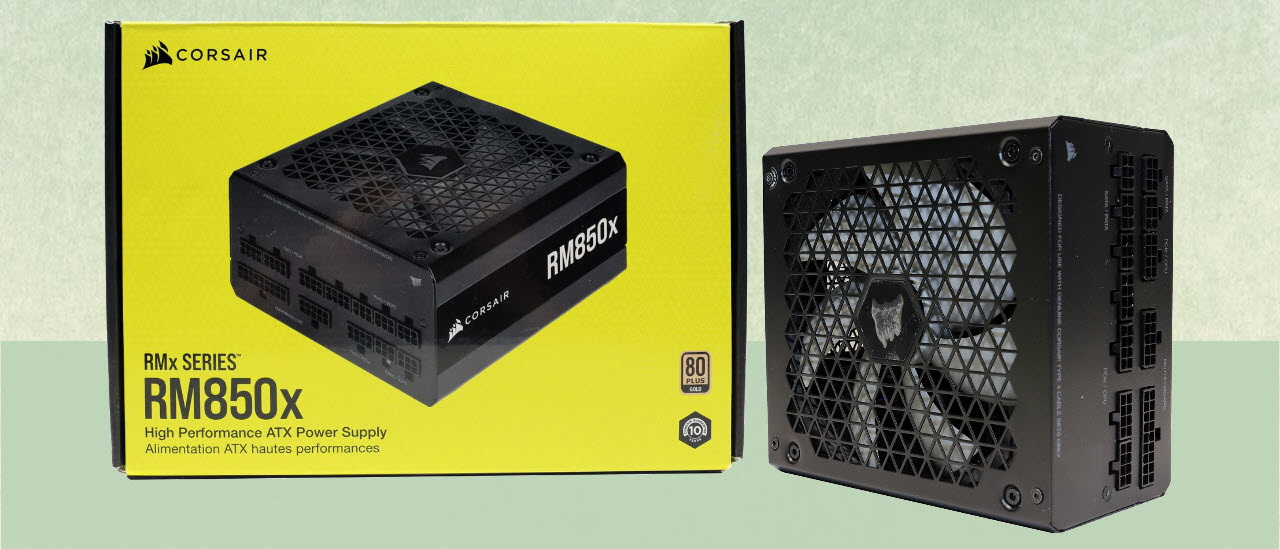Tom's Hardware Verdict
Corsair managed to improve the already great RM850x, offering even higher performance and a magnetic levitation fan.
Pros
- +
Full power at 47 degrees Celsius
- +
High overall performance
- +
Quiet operation
- +
Fully compliant with ATX v2.52
- +
Highly efficient at light loads
- +
Long hold-up time
- +
Low inrush currents
- +
Magnetic Levitation fan
- +
Loads of cables and connectors
- +
Fully modular
- +
10-year warranty
Cons
- -
High OCP triggering points on the minor rails
- -
Transient response at 3.3V could be better
- -
In-cable capacitors
- -
Small distance between peripheral connectors
Why you can trust Tom's Hardware
It is tough to upgrade something that's already quite good. But Corsair managed to do so with the RM850x power supply, improving the efficiency at light loads, adding one more EPS connector, and using a top-notch magnetic levitation fan. This is a product worthy of our list of the best power supplies. Its competitors include the XPG Core Reactor 850W and the similar capacity Cooler Master V850 Gold V2 model. The more affordable Corsair RM850, which is close in performance to the RM850x, is another fine option in this category.
Corsair's RMx line is among the most popular in today's mid-segment PSU market, so updating was a daunting task.
The use of a magnetic levitation fan is a great asset. The rifle bearing used in the previous generation RMx line was good, but there is no comparison with the ML fan that the new units utilize; Rifle and fluid dynamic bearings cannot cope with high operating temperatures. The only problem is the more aggressive fan profile, but updates from Corsair mean the new RM850x batches have lower average noise output than the initial production units.
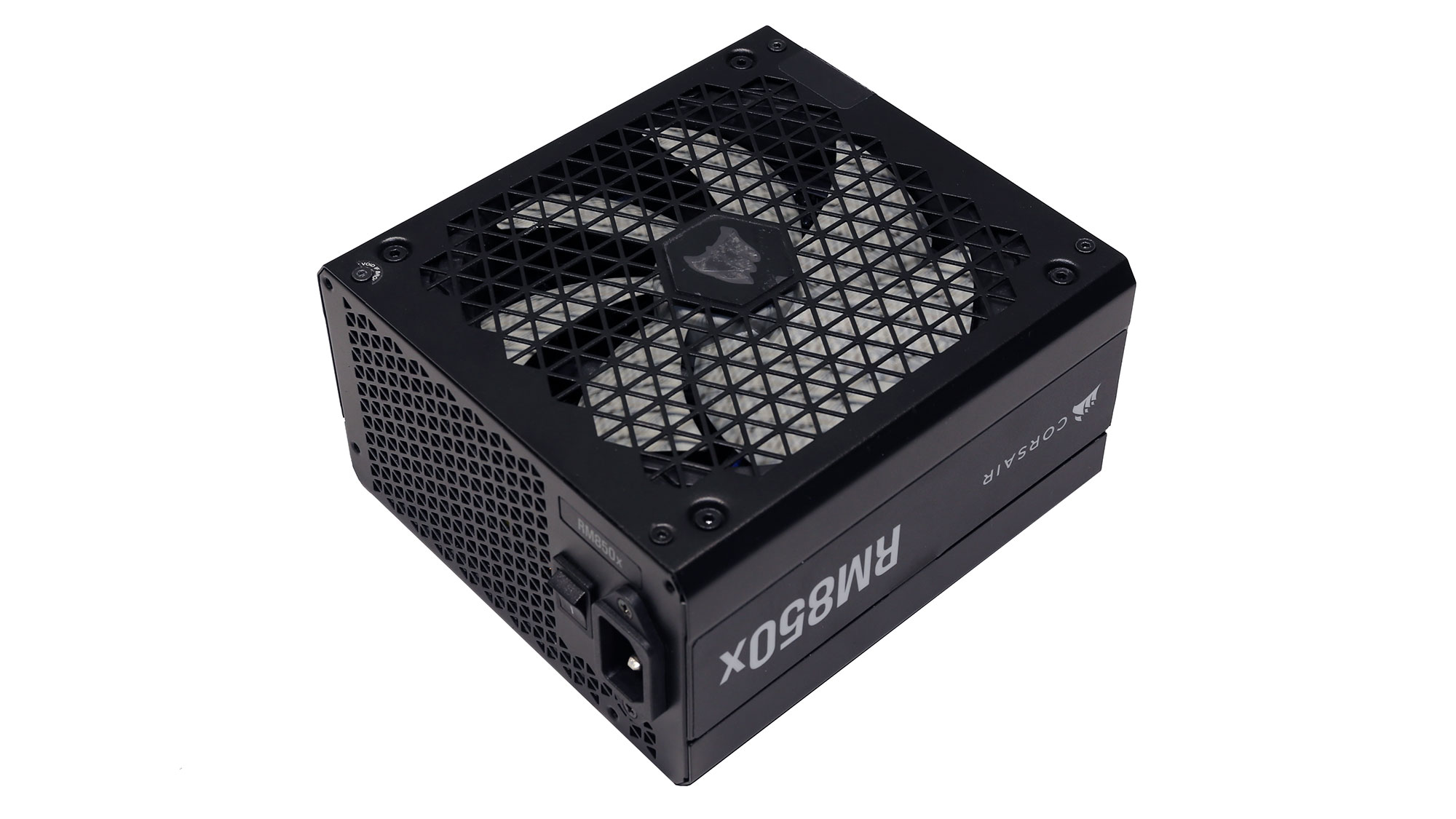
Product Photos

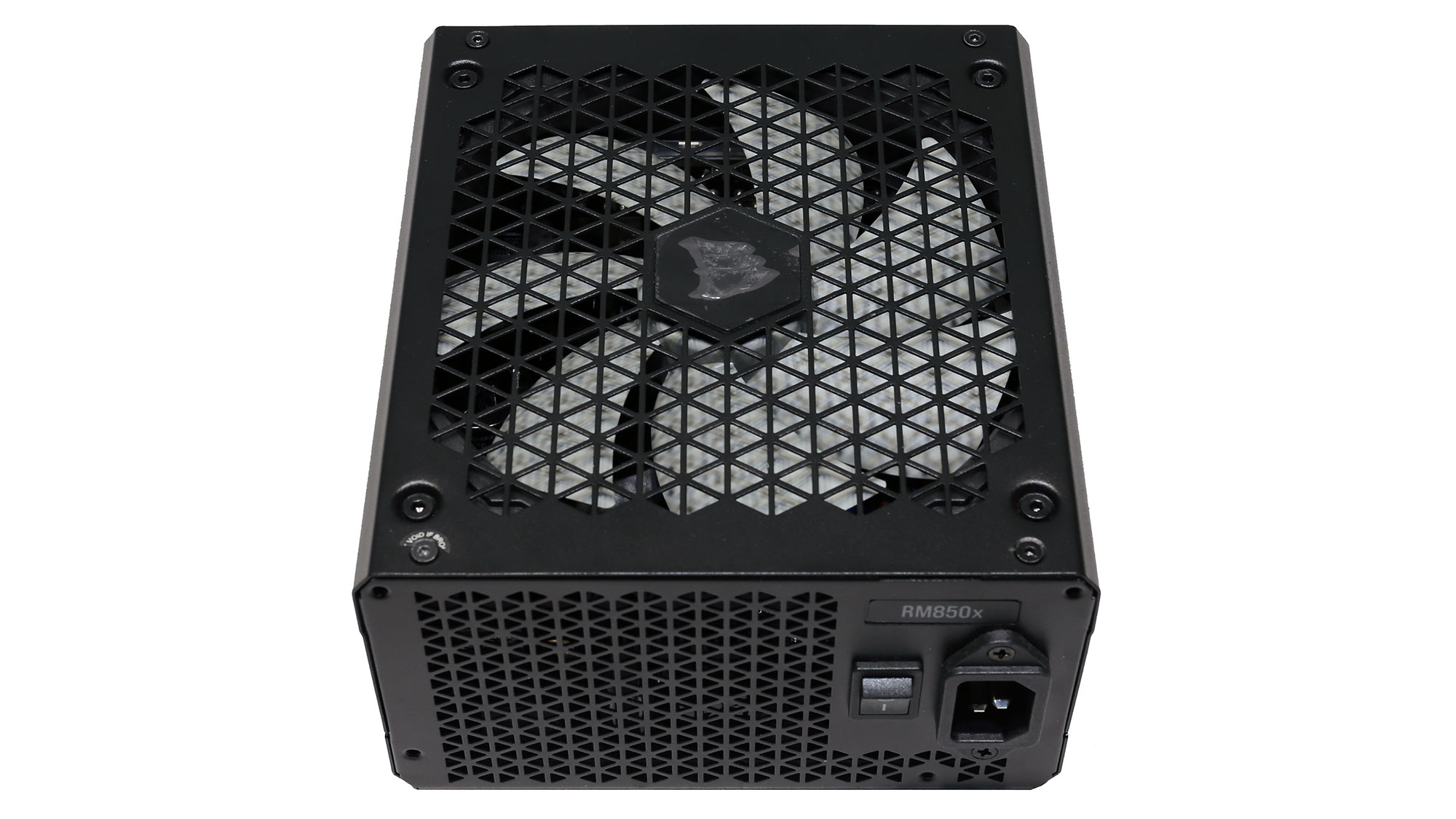

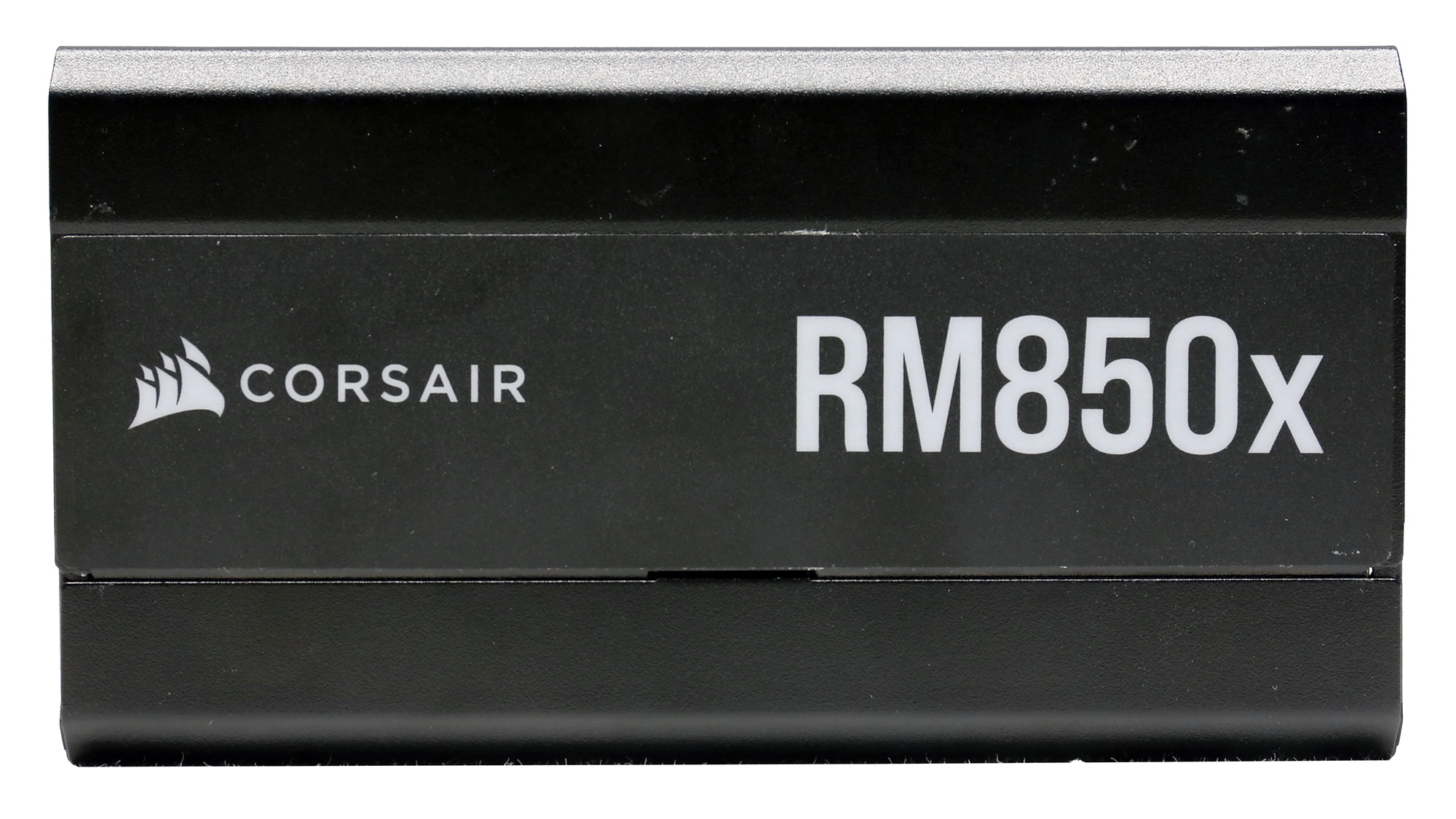






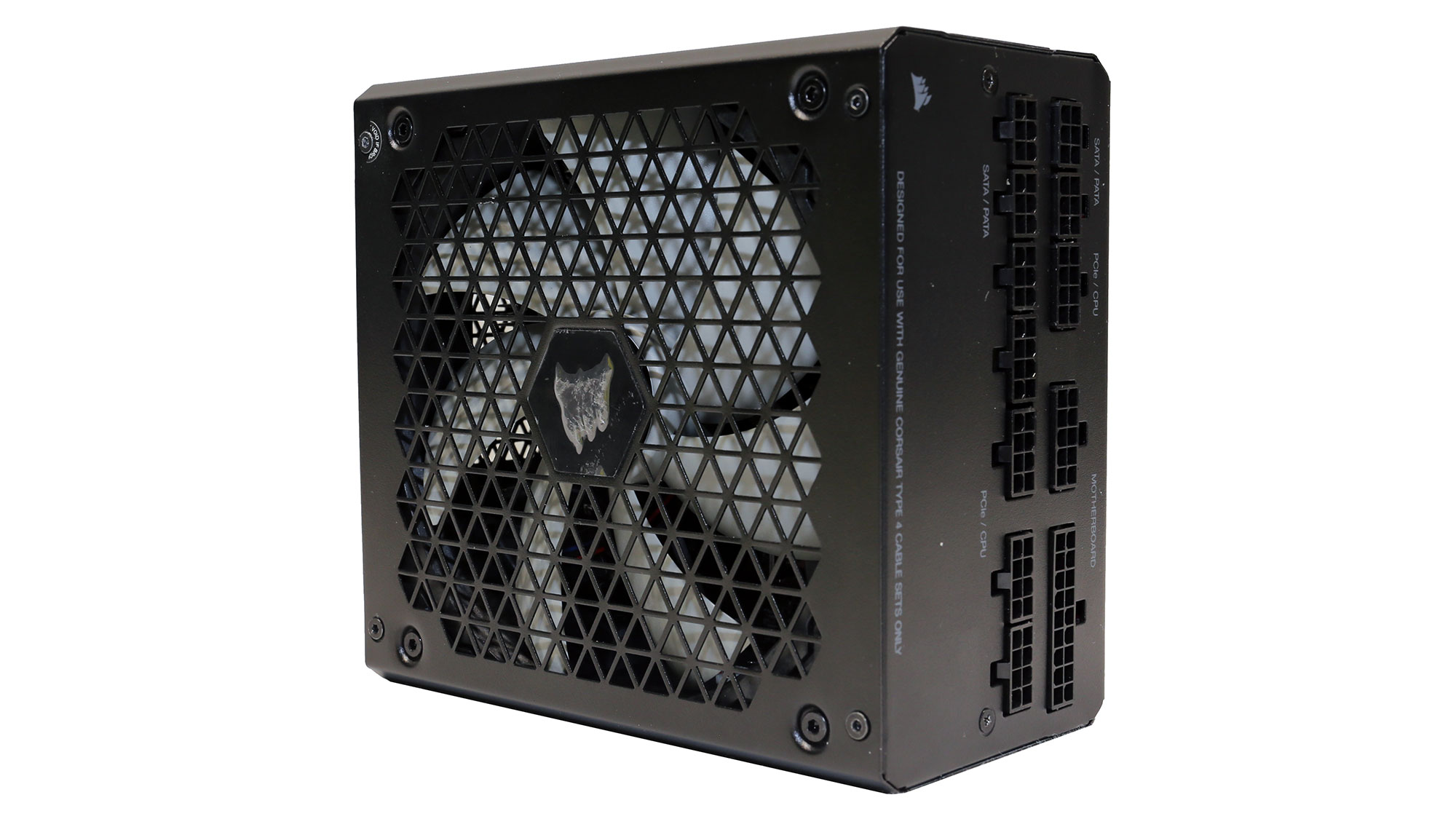
The RM850x (2021) is the strongest member of the line, with enough power to handle a strong gaming system or a video editing workstation. To support the ultra-high-end mainboard, Corsair equipped it with three EPS connectors, something that's hard to find in today's market, even in stronger PSUs. The fully modular cable design is a must in this price range, and the same goes for the ten-year warranty, from the moment all competing offerings are supported by equally long warranty periods. Lastly, the PSU's dimensions are normal with 160mm length, so there won't be any compatibility issues with ATX cases.
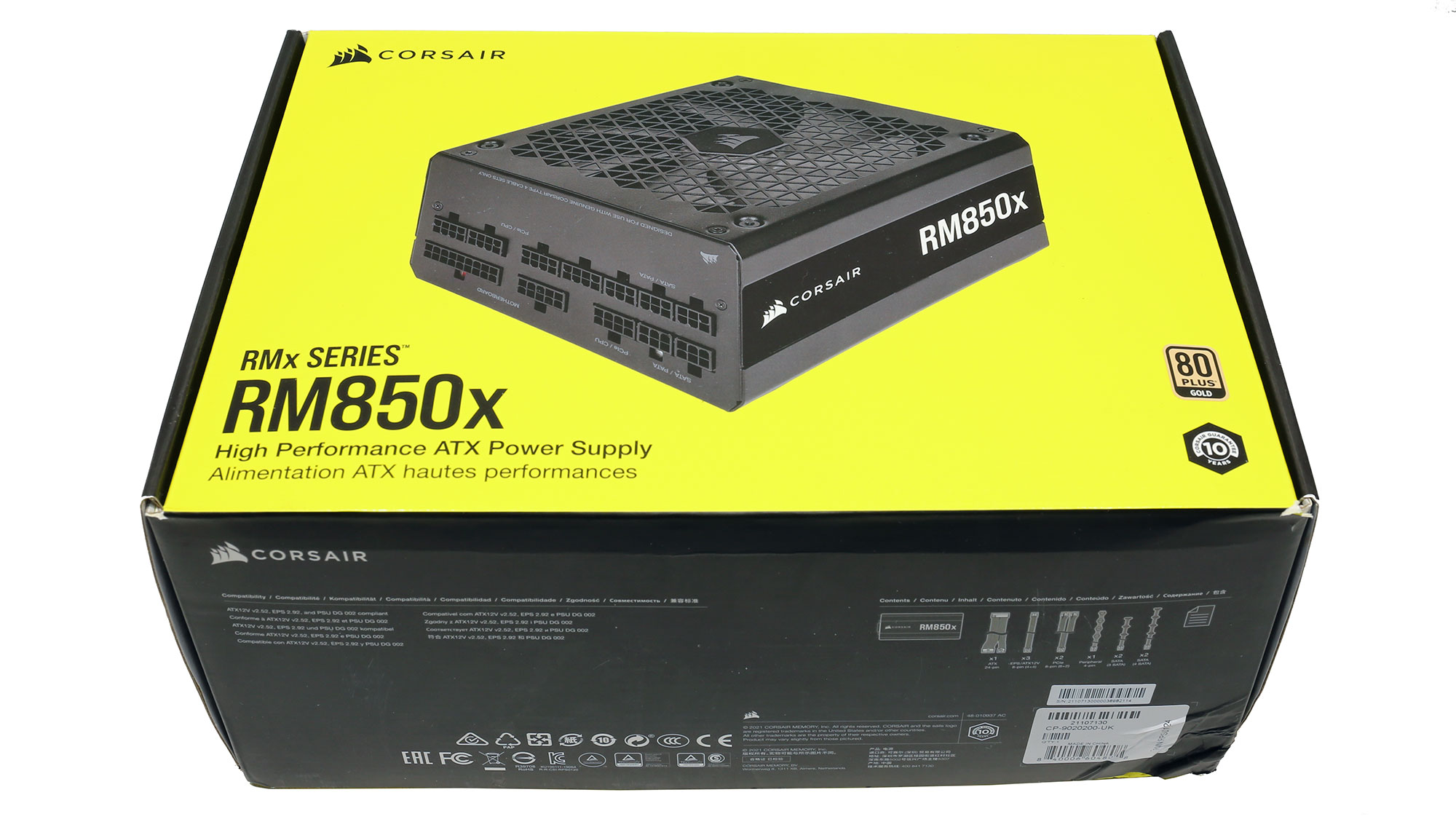
Product Photos
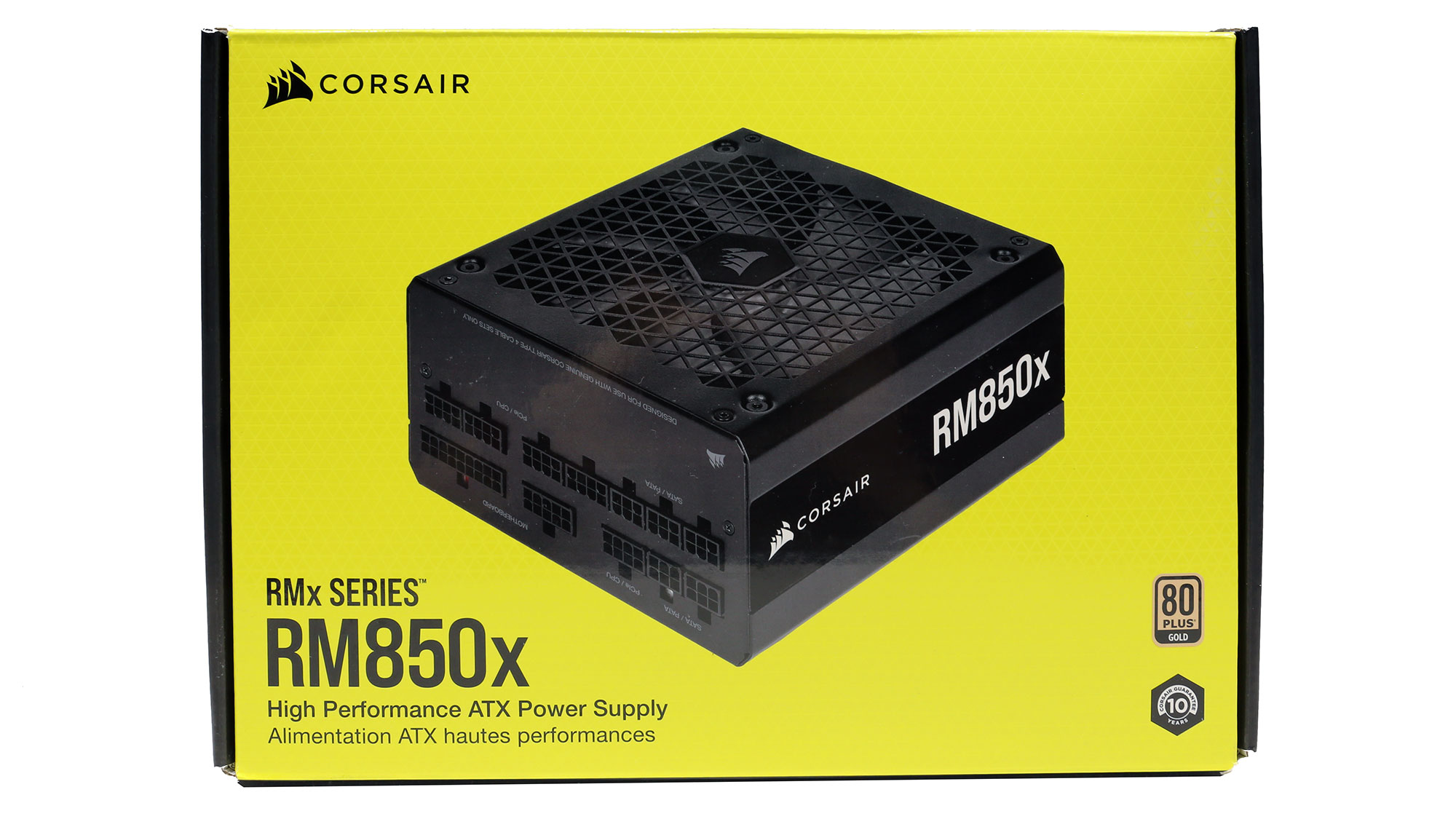
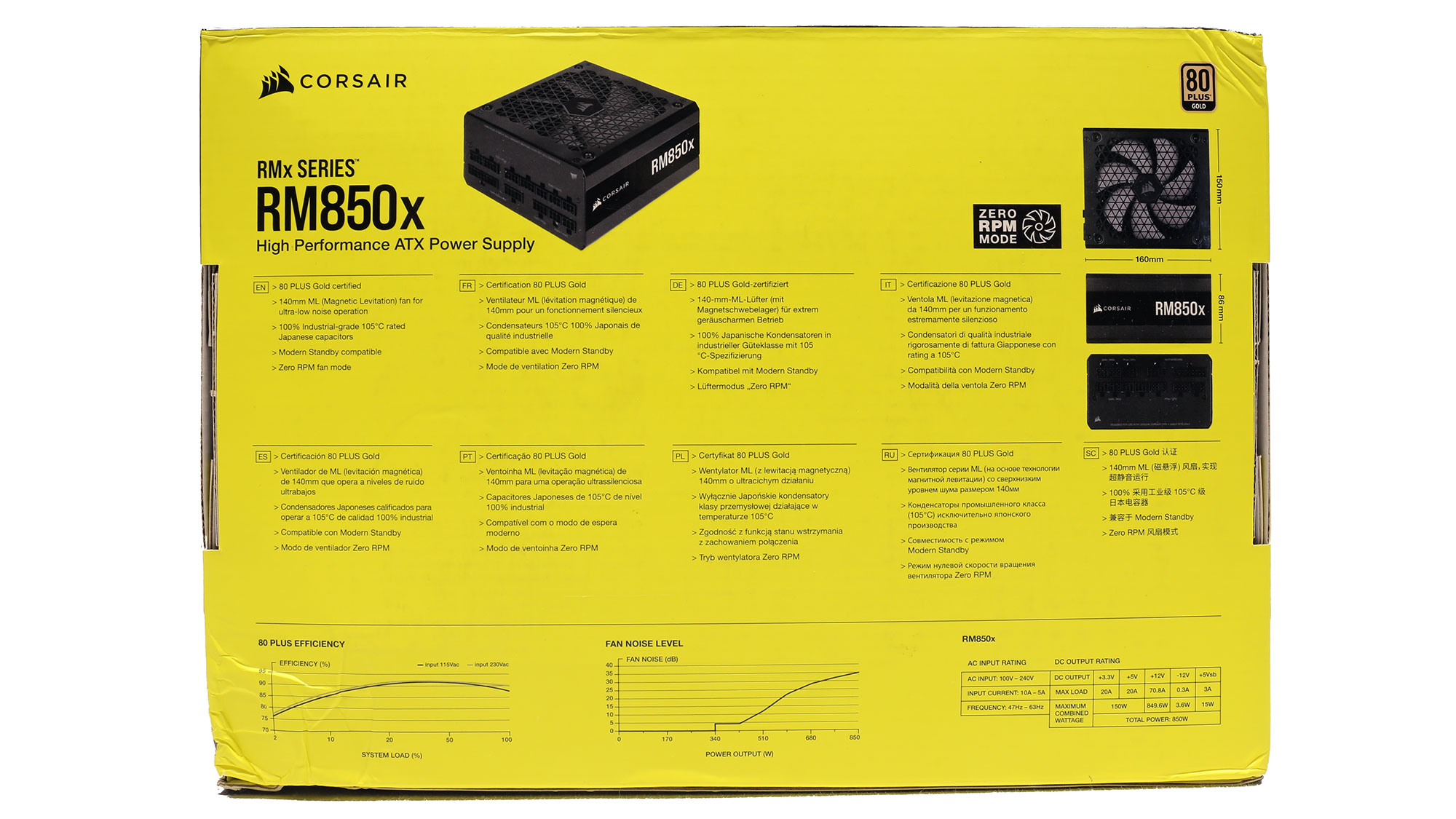
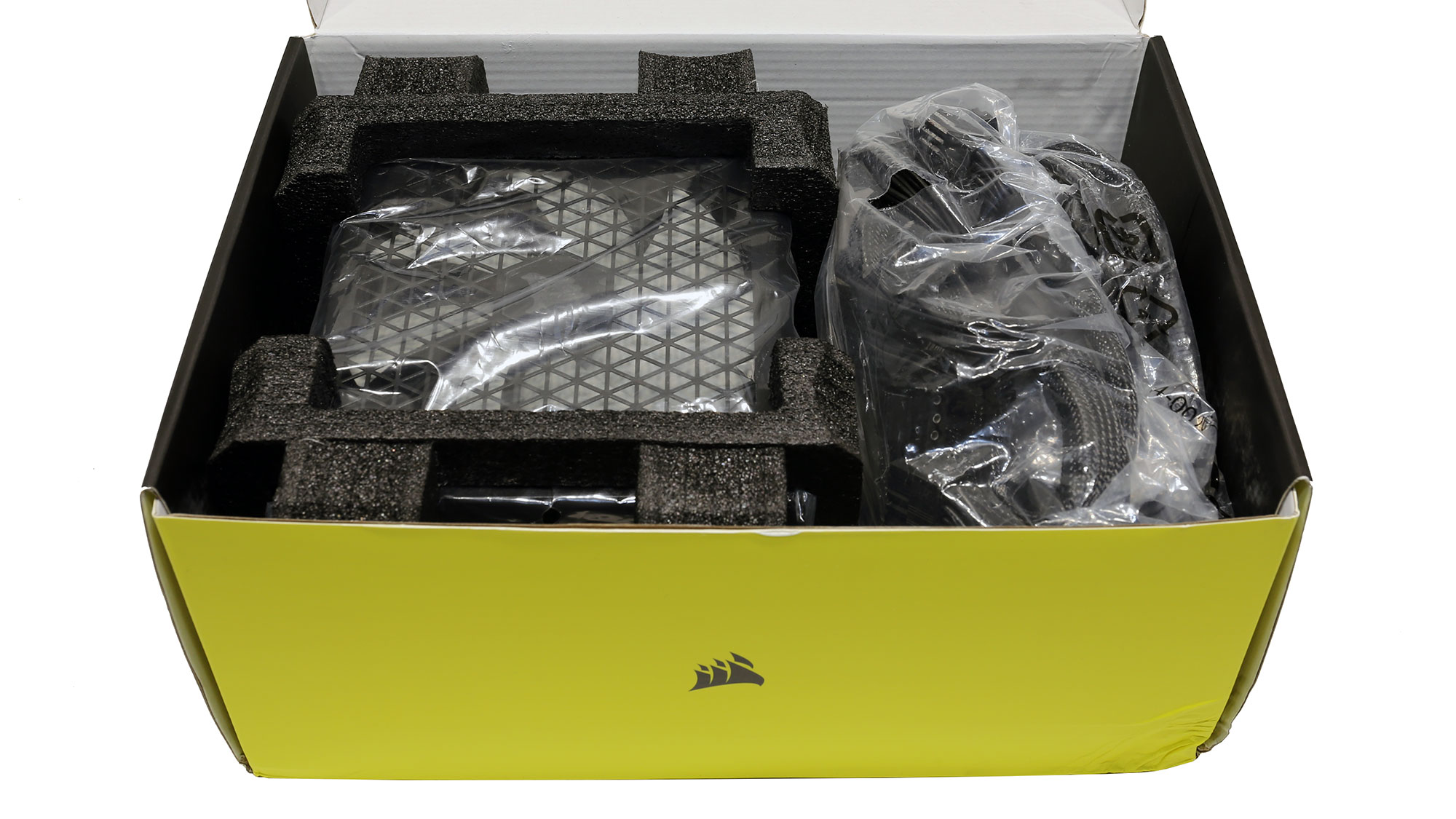


Specifications
|
Manufacturer (OEM) |
CWT |
|
Max. DC Output |
850W |
|
Efficiency |
80 PLUS Gold, Cybenetics Gold (87-89%) |
|
Noise |
Cybenetics A- (25-30 dB[A]) |
|
Modular |
✓ (Fully) |
|
Intel C6/C7 Power State Support |
✓ |
|
Operating Temperature (Continuous Full Load) |
0 - 50°C |
|
Over Voltage Protection |
✓ |
|
Under Voltage Protection |
✓ |
|
Over Power Protection |
✓ |
|
Over Current (+12V) Protection |
✓ |
|
Over Temperature Protection |
✓ |
|
Short Circuit Protection |
✓ |
|
Surge Protection |
✓ |
|
Inrush Current Protection |
✓ |
|
Fan Failure Protection |
✗ |
|
No Load Operation |
✓ |
|
Cooling |
140mm Magnetic Levitation Fan (NR140ML) |
|
Semi-Passive Operation |
✓ |
|
Dimensions (W x H x D) |
150 x 85 x 160mm |
|
Weight |
1.71 kg (3.77 lb) |
|
Form Factor |
ATX12V v2.53, EPS 2.92 |
|
Warranty |
10 Years |
Power Specifications
| Rail | 3.3V | 5V | 12V | 5VSB | -12V | |
|---|---|---|---|---|---|---|
| Max. Power | Amps | 20 | 20 | 70.8 | 3 | 0.3 |
| Watts | 150 | 849.6 | 15 | 3.6 | ||
| Total Max. Power (W) | 850 |
Cables & Connectors
| Description | Cable Count | Connector Count (Total) | Gauge | In Cable Capacitors |
|---|---|---|---|---|
| ATX connector 20+4 pin (610mm) | 1 | 1 | 16-20AWG | Yes |
| 4+4 pin EPS12V (650mm) | 3 | 3 | 18AWG | Yes |
| 6+2 pin PCIe (600mm+150mm) | 2 | 4 | 16-18AWG | Yes |
| SATA (500mm+110mm+110mm+110mm) | 2 | 8 | 18AWG | No |
| SATA (520mm+110mm+110mm) | 2 | 6 | 18AWG | No |
| 4-pin Molex (450mm+100mm+100mm+100mm) | 1 | 4 | 18AWG | No |
| AC Power Cord (1400mm) - C13 coupler | 1 | 1 | 18AWG | - |
The cables are long enough, and it is impressive to see three EPS and four PCIe available. There is no need for more PCIe, given that the majority of users have a single graphics card installed. The only letdown is the small distance between the peripheral connectors.
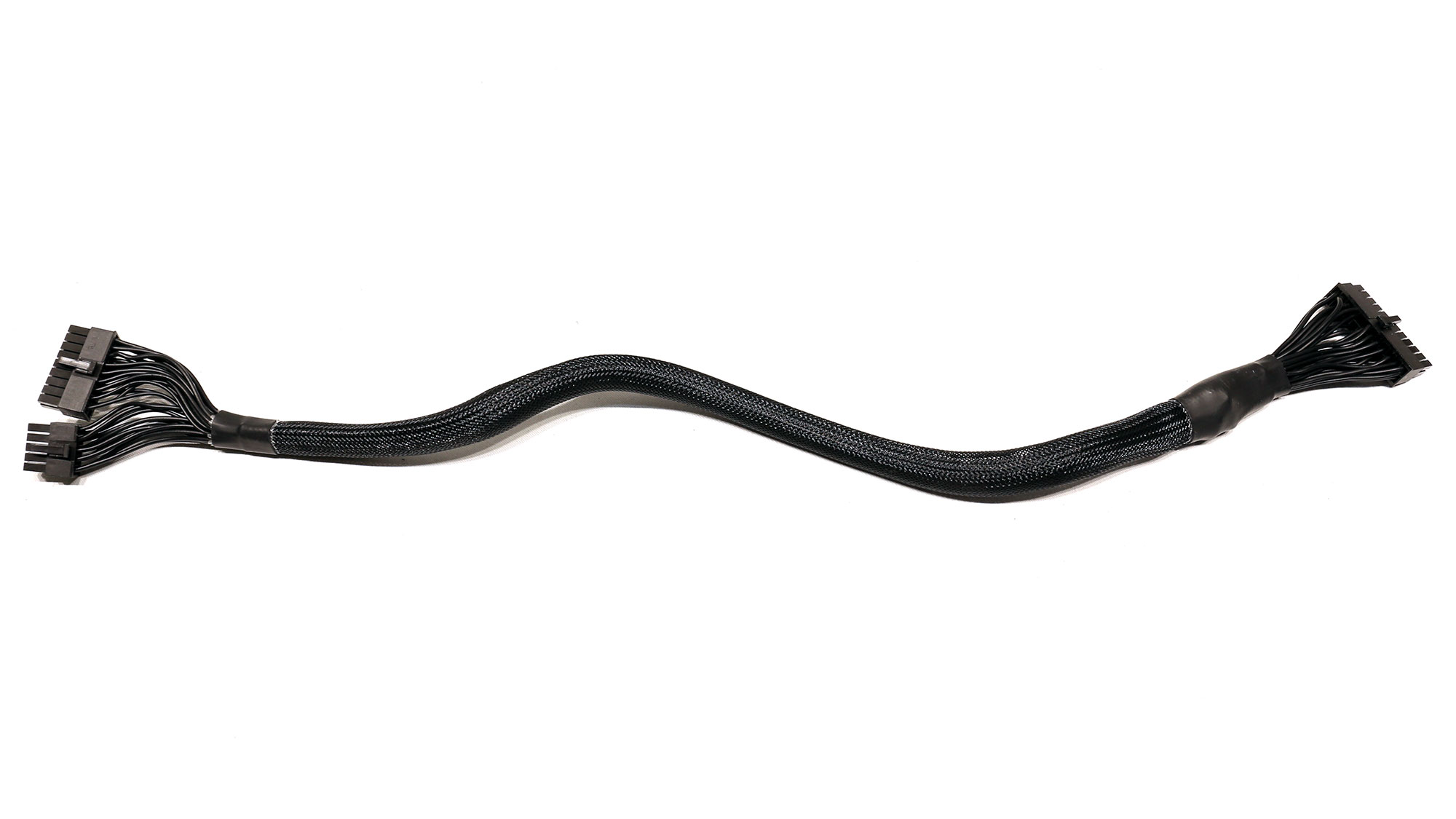
Cable Photos
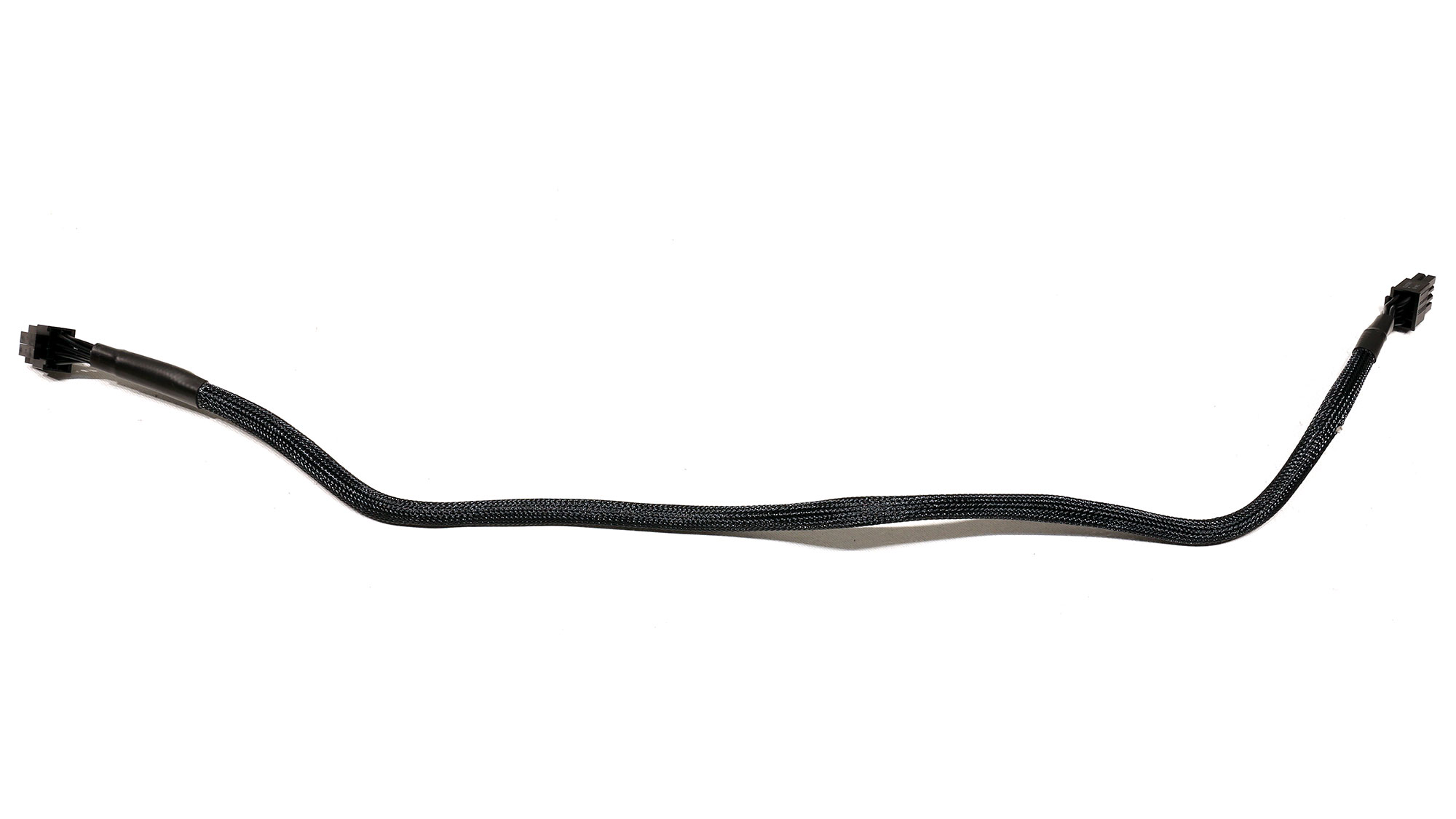

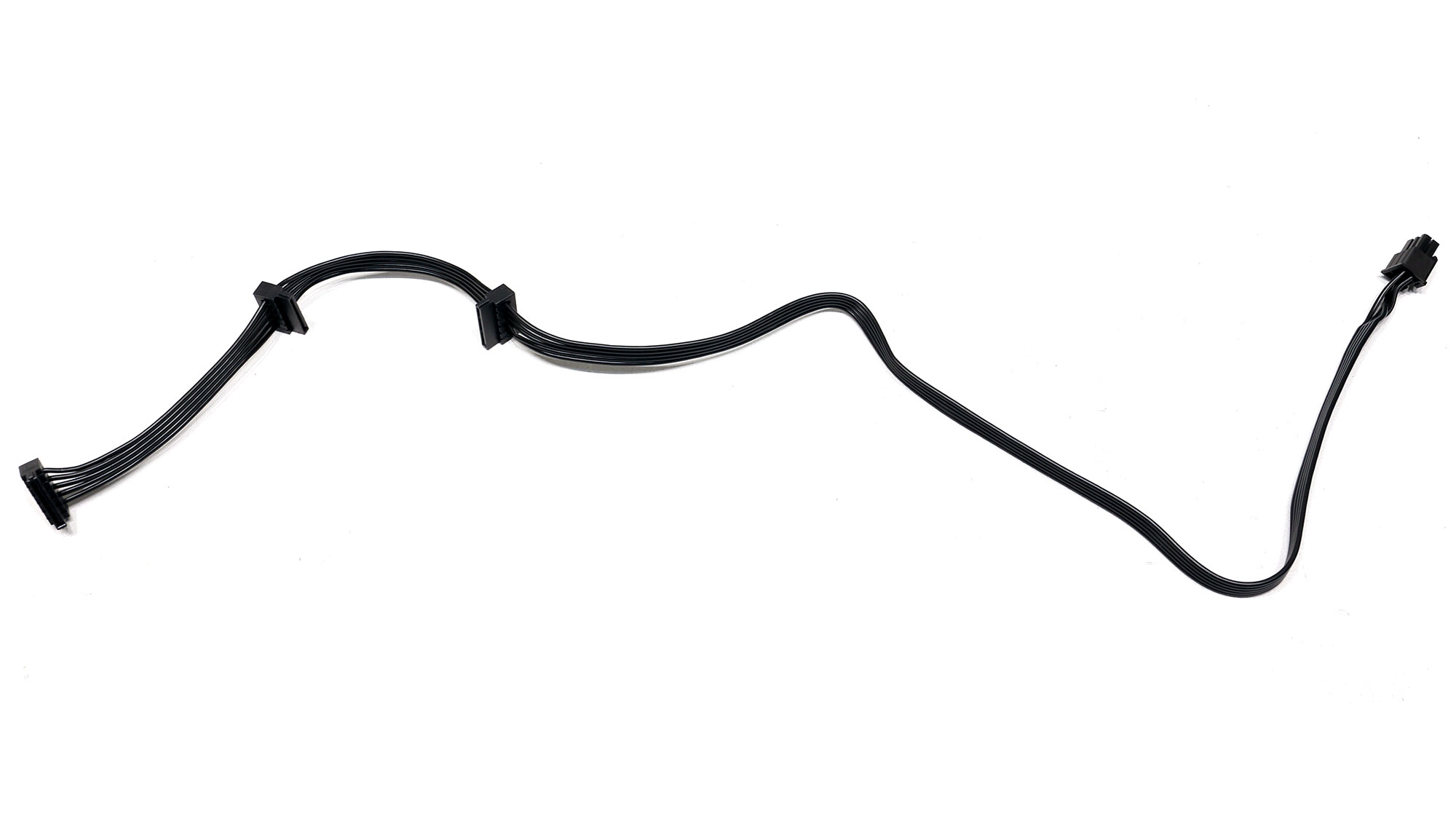
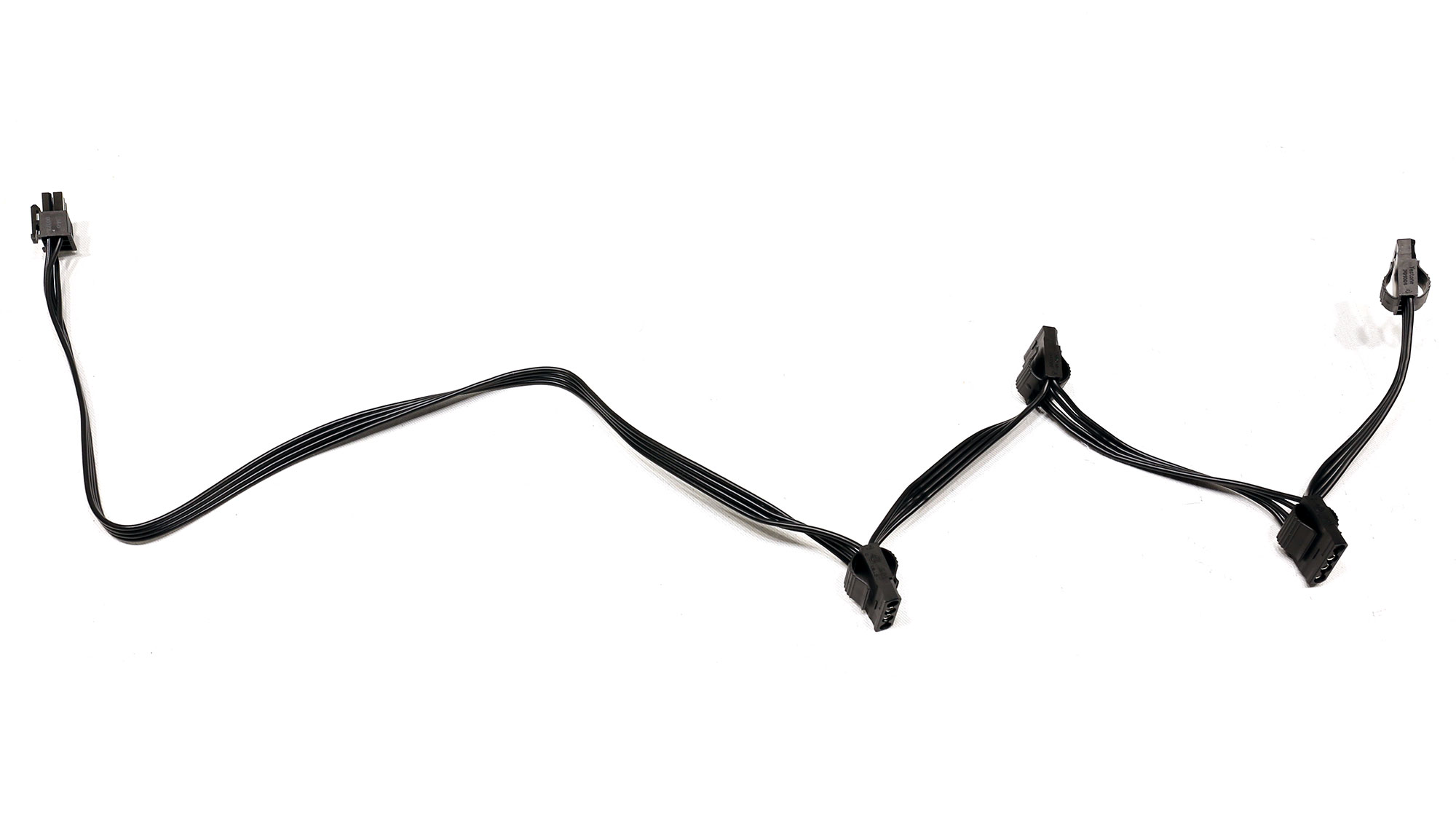
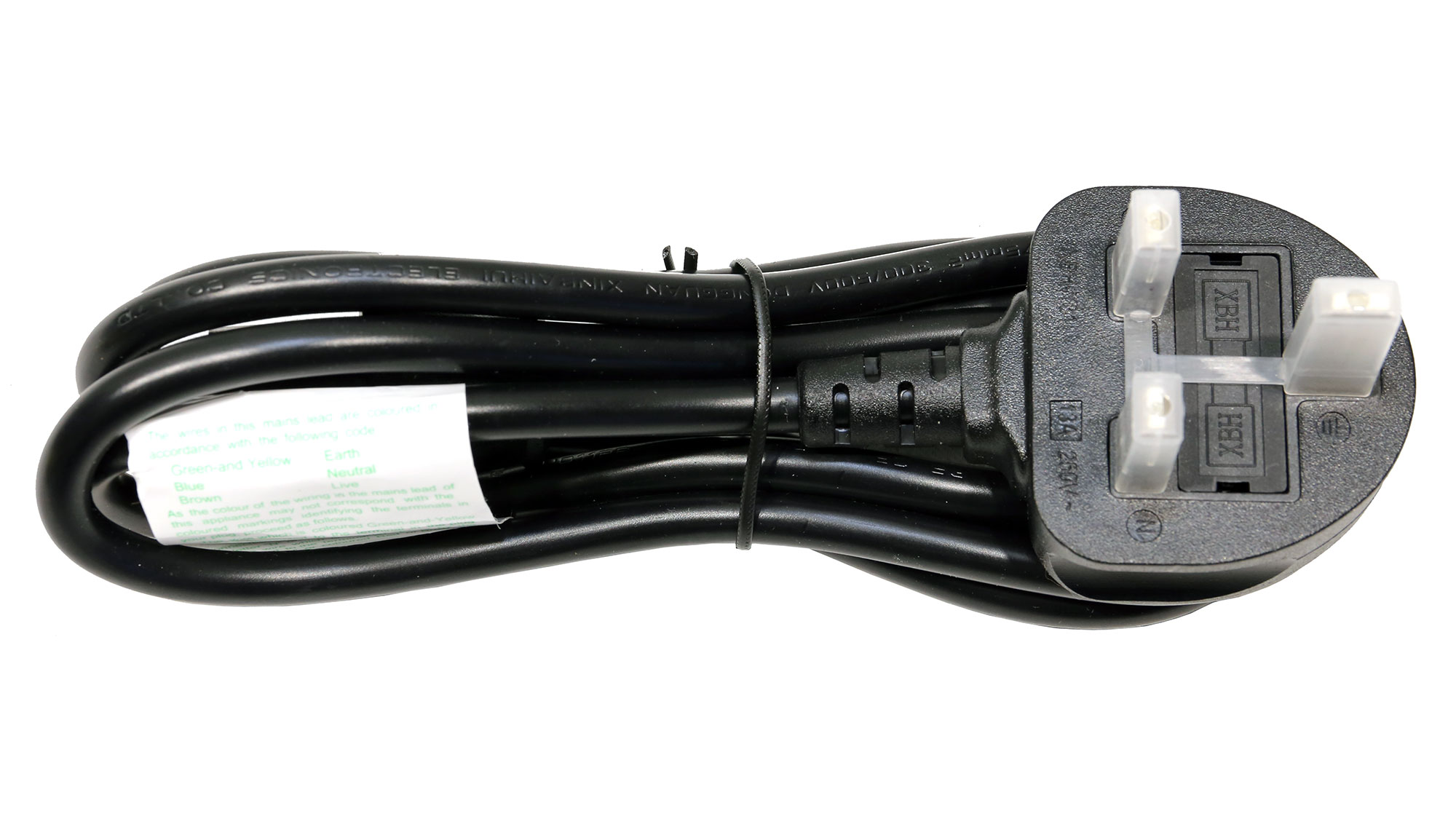
Component Analysis
We strongly encourage you to have a look at our PSUs 101 article, which provides valuable information about PSUs and their operation, allowing you to better understand the components we're about to discuss.
| General Data | - |
| Manufacturer (OEM) | CWT |
| PCB Type | Double Sided |
| Primary Side | - |
| Transient Filter | 4x Y caps, 2x X caps, 2x CM chokes, 1x MOV |
| Inrush Protection | NTC Thermistor SCK-037 (3 Ohm) & Relay |
| Bridge Rectifier(s) | 2x GBU1506 (600V, 15A @ 100°C) |
| APFC MOSFETs | 2x Vishay SiHF30N60E (650V, 18A @ 100°C, Rds(on): 0.125Ohm) |
| APFC Boost Diode | 1x On Semiconductor FFSP0865A (650V, 8A @ 155°C) |
| Bulk Cap(s) | 2x Nippon Chemi-Con (400V, 470uF each or 940uF combined, 2,000h @ 105°C, KMW) |
| Main Switchers | 2x On Semiconductor FCPF190N60E (600V, 13.1A @ 100°C, Rds(on): 0.19Ohm) |
| APFC Controller | Champion CM6500UNX & Champion CM03X |
| Resonant Controller | Champion CU6901VAC |
| Topology |
Primary side: APFC, Half-Bridge & LLC converter Secondary side: Synchronous Rectification & DC-DC converters |
| Secondary Side | - |
| +12V MOSFETs | 6x On Semiconductor NTMFS5C430N (40V, 131A @ 100°C, Rds(on): 1.7mOhm) |
| 5V & 3.3V |
DC-DC Converters: 2x UBIQ QM3054M6 (30V, 61A @ 100°C, Rds(on): 4.8mOhm) & 2x UBIQ QN3107M6N (30V, 70A @ 100°C, Rds(on): 2.6mOhm) |
| Filtering Capacitors |
Electrolytic: 7x Nippon Chemi-Con (1-5,000h @ 105°C, KZE), 7x Nippon Chemi-Con (4-10,000h @ 105°C, KY), 1x Rubycon (4-10,000h @ @ 105°C, YXJ) |
| Change Over Switch | 1x Sync Power SPN3006 MOSFET (30V, 57A @ 100°C, Rds(on): 5.5mOhm) |
| Supervisor IC | Weltrend WT7502R (OVP, UVP, SCP, PG) |
| Fan Controller | Microchip PIC16F1503 |
| Fan Model | Corsair NR140ML (140mm, 12V, 0.27A, Magnetic Levitation Bearing Fan) |
| 5VSB Circuit | - |
| Rectifiers | 1x PS1045L SBR (45V, 10A) & IPS ISD04N65A (650V, 2.5A @ 100°C, Rds(on): 2.2 Ohm) |
| Standby PWM Controller | On-Bright OB5282 |
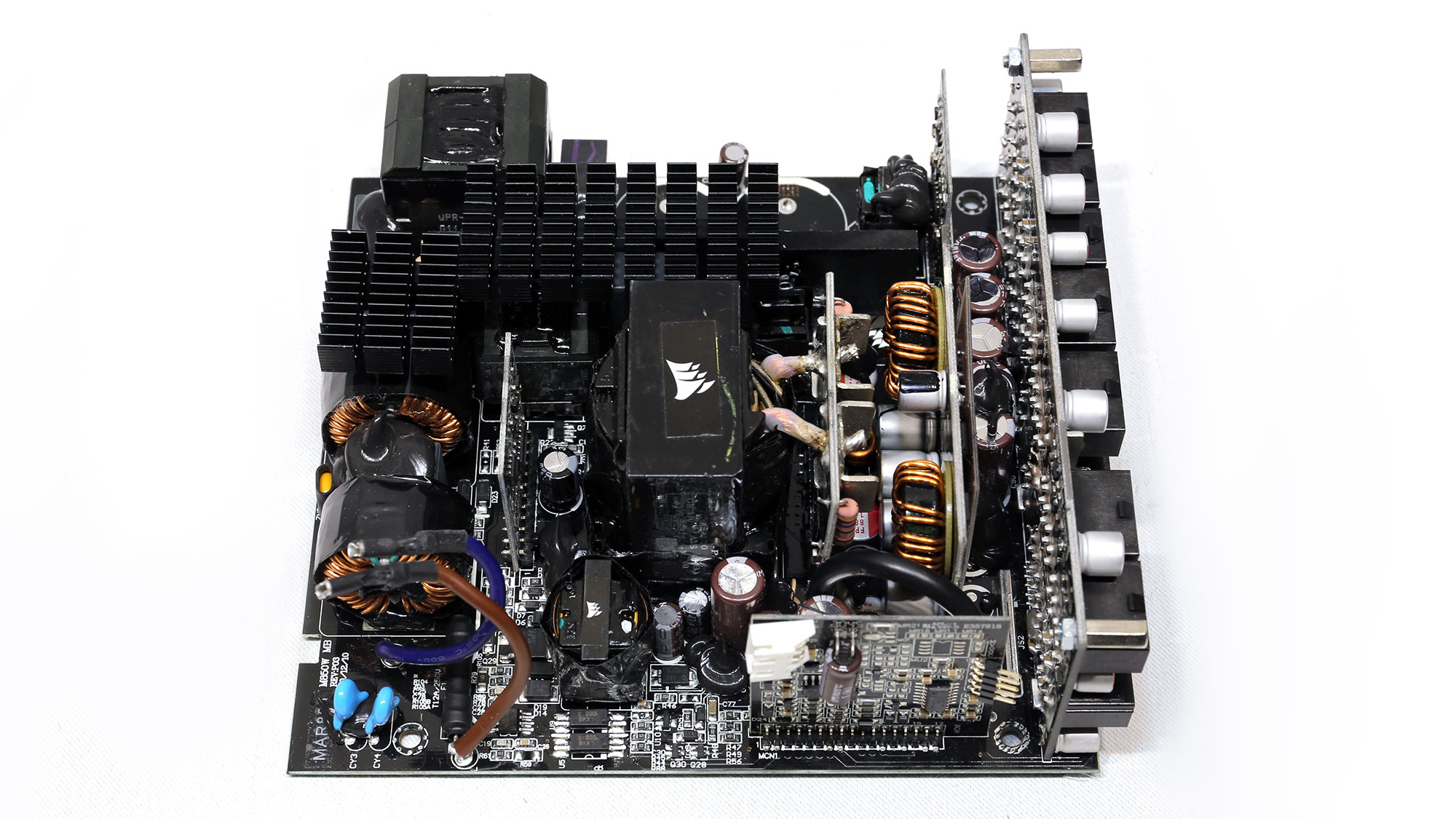
Overall Photos

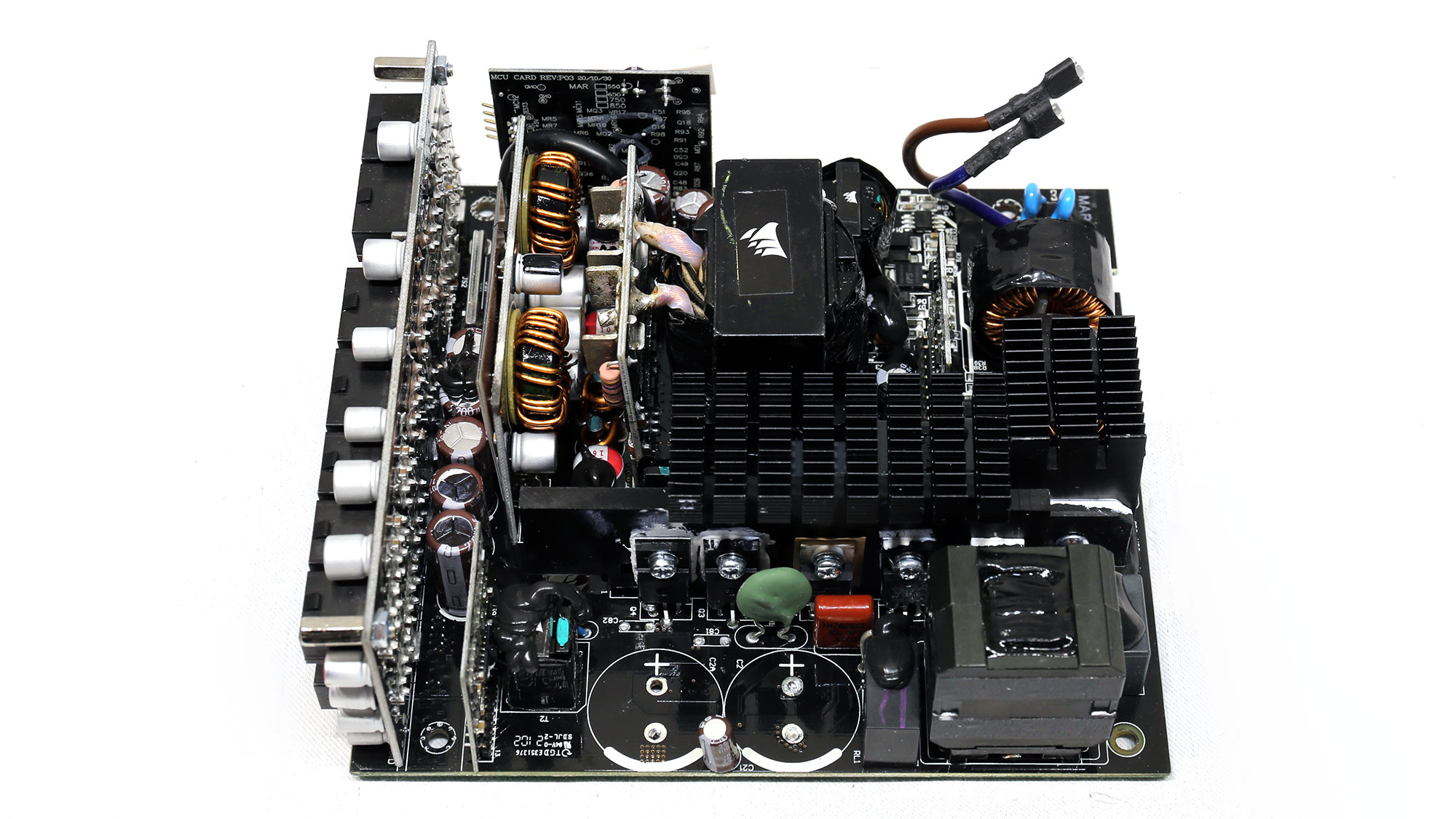

Channel Well Technology (CWT) remains the OEM of the RMx line, and it did a great job under Corsair's strict supervision. The platform has some differences from the older one to provide increased efficiency at light loads and support for alternative sleep modes. The most important change is the new fan, with ML bearings. These fans do not come cheap, so it is a nice surprise that Corsair decided to use them in the new RMx line.
Get Tom's Hardware's best news and in-depth reviews, straight to your inbox.
The build quality is good overall. Corsair used Japanese capacitors on both primary and secondary sides, and known manufacturers provide the FETs.

Transient filter
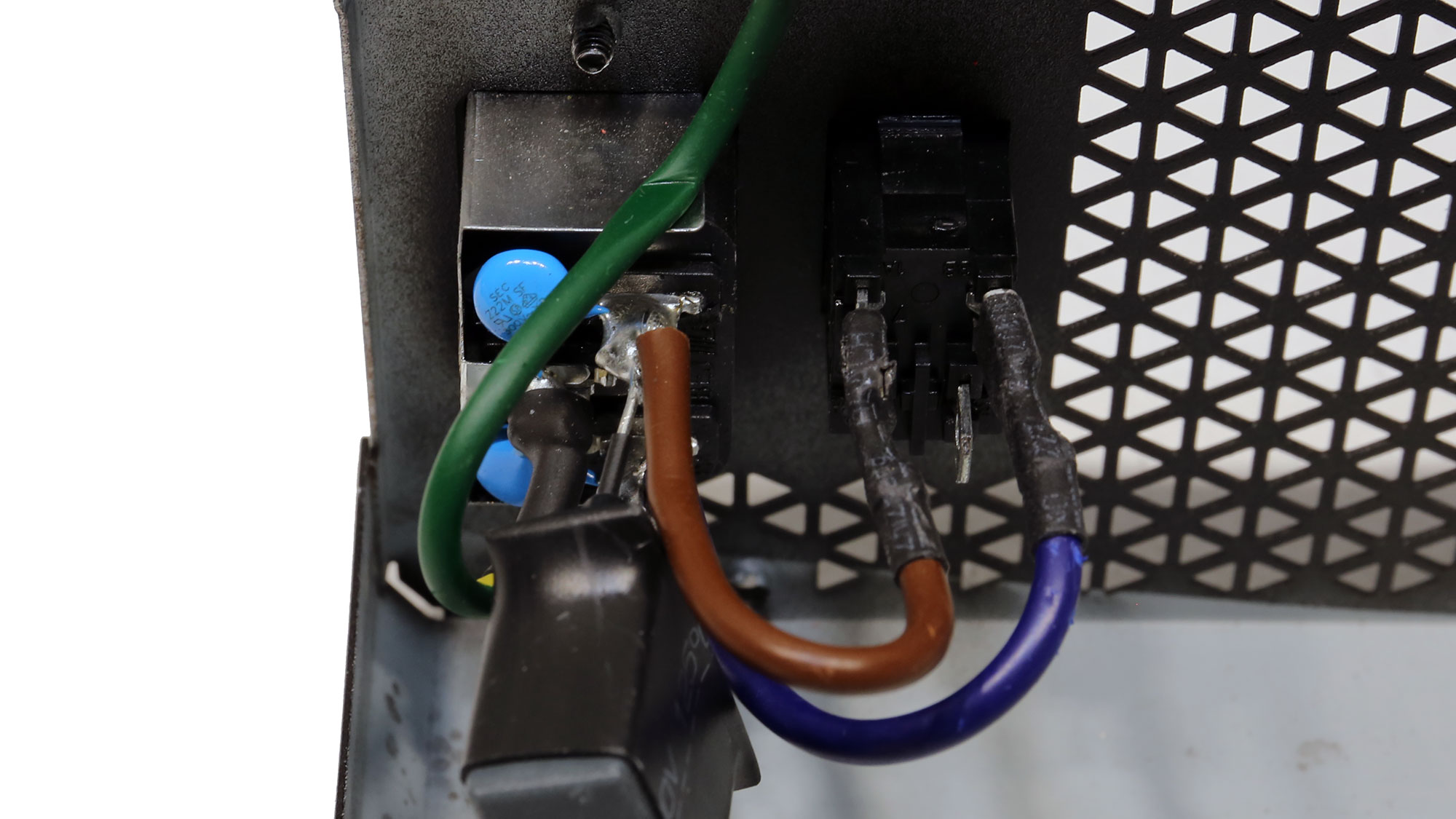
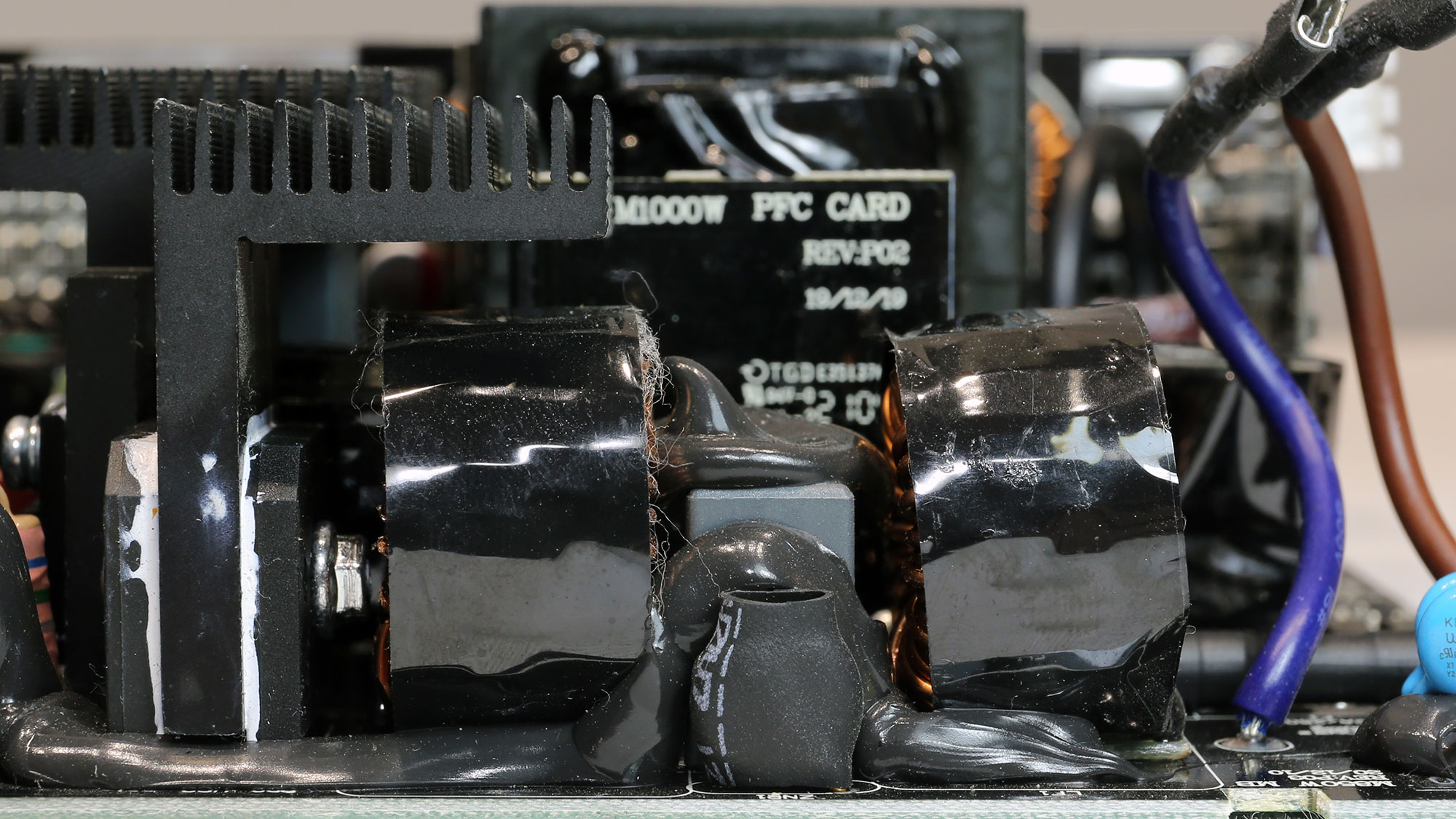
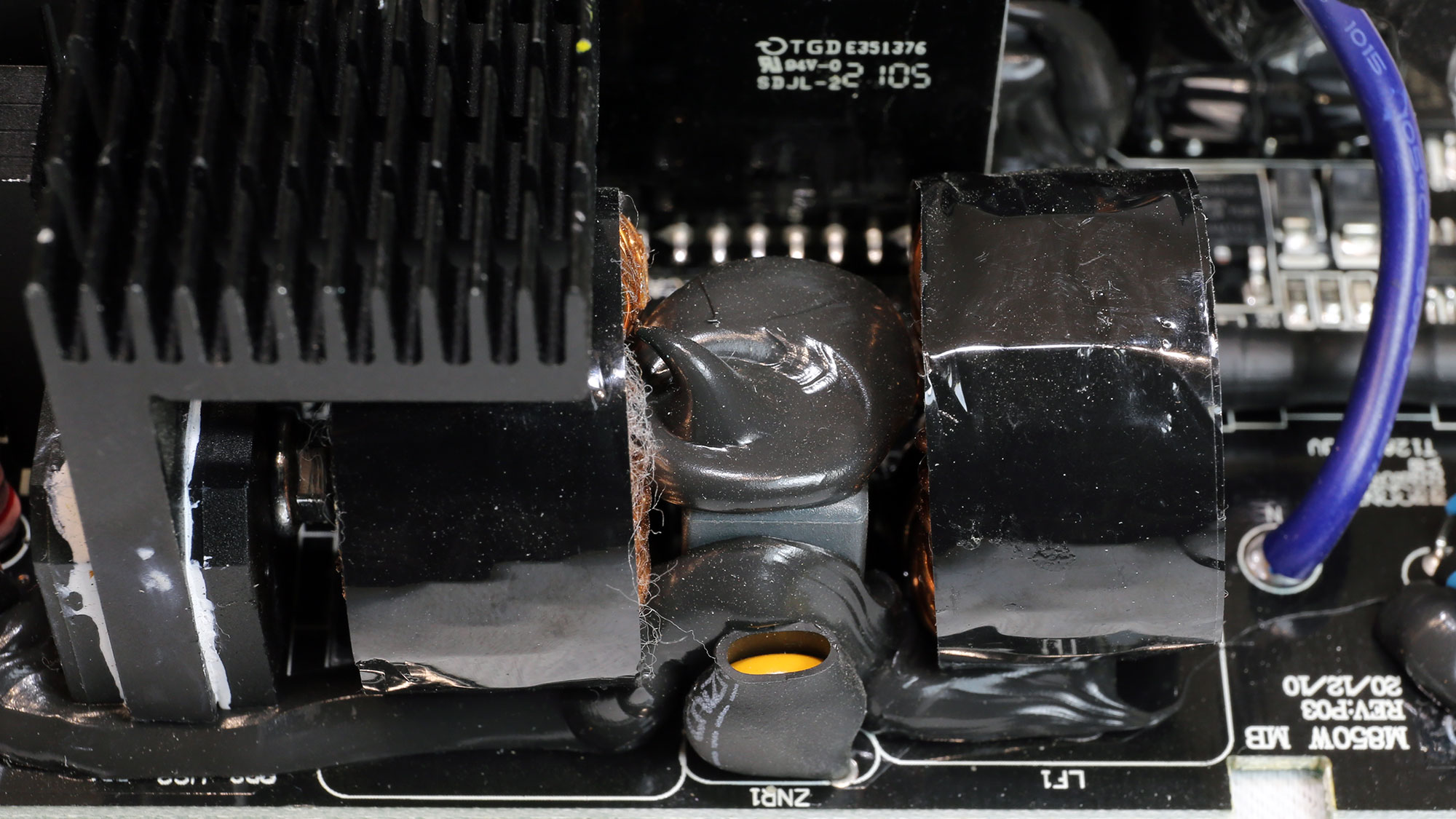

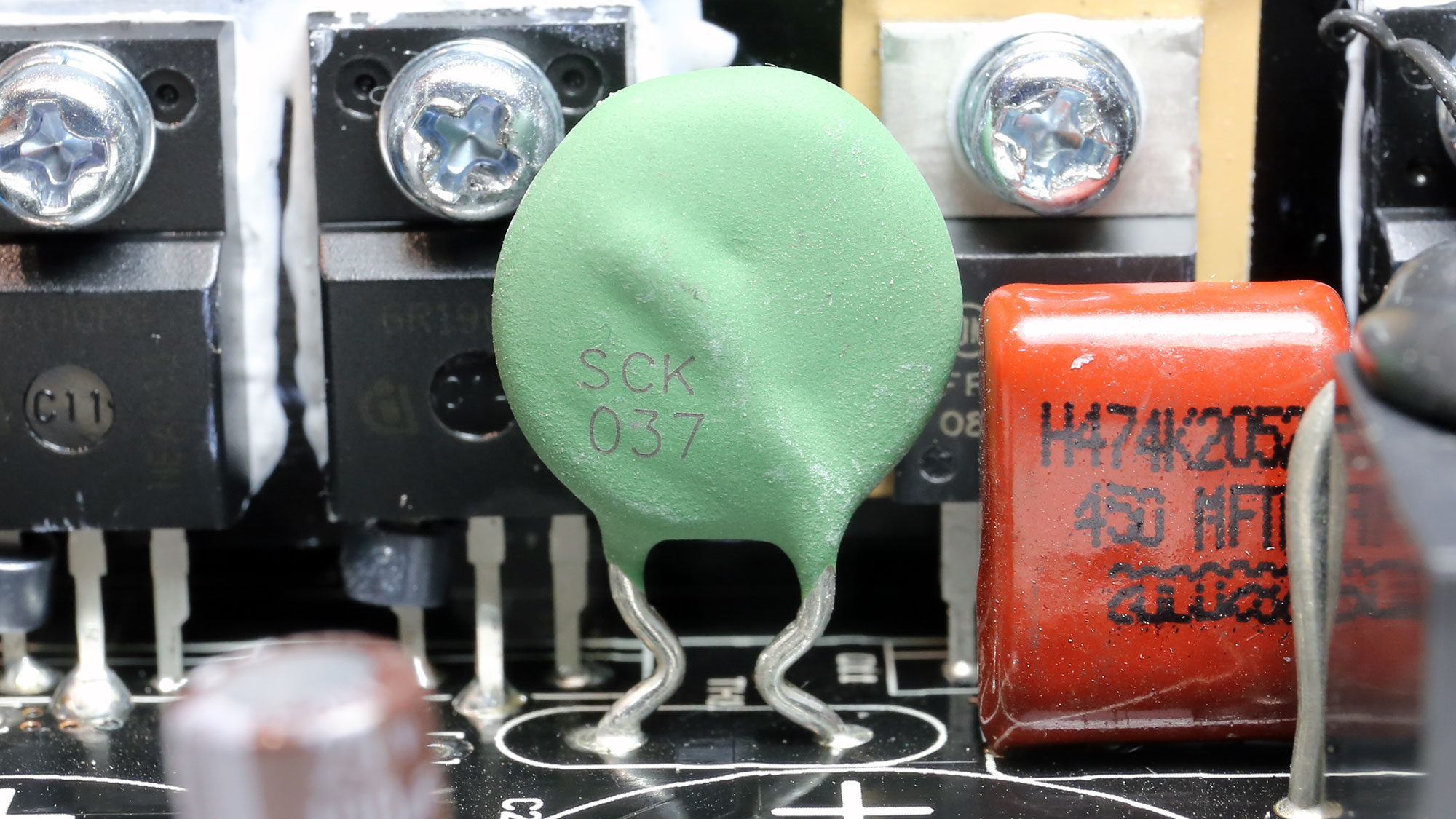

The transient/EMI filter has all necessary parts and it does a good job, in restricting EMI emissions.
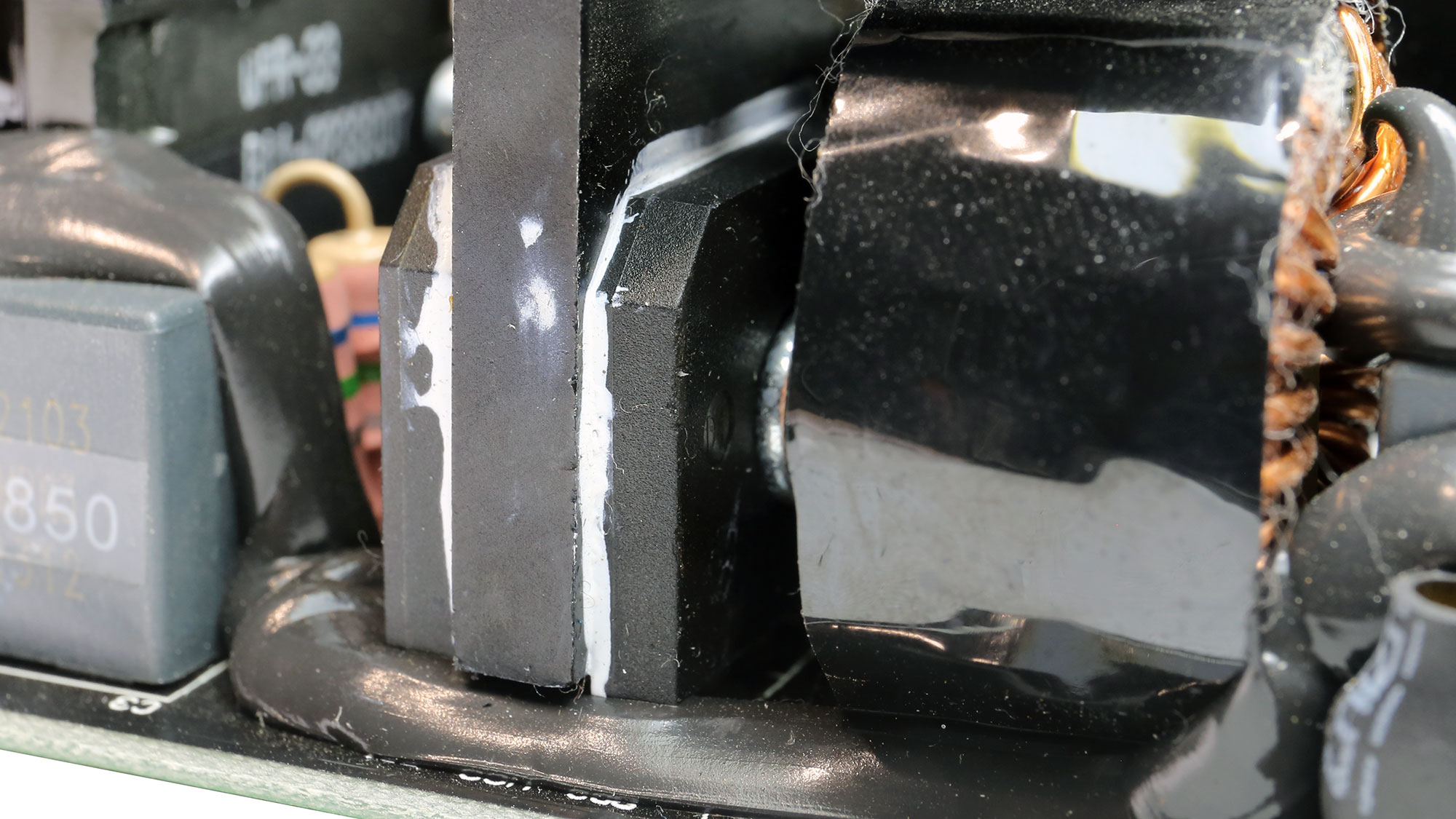
Bridge rectifiers

The two powerful bridge rectifiers are more than enough to handle the max power that this platform can deliver.
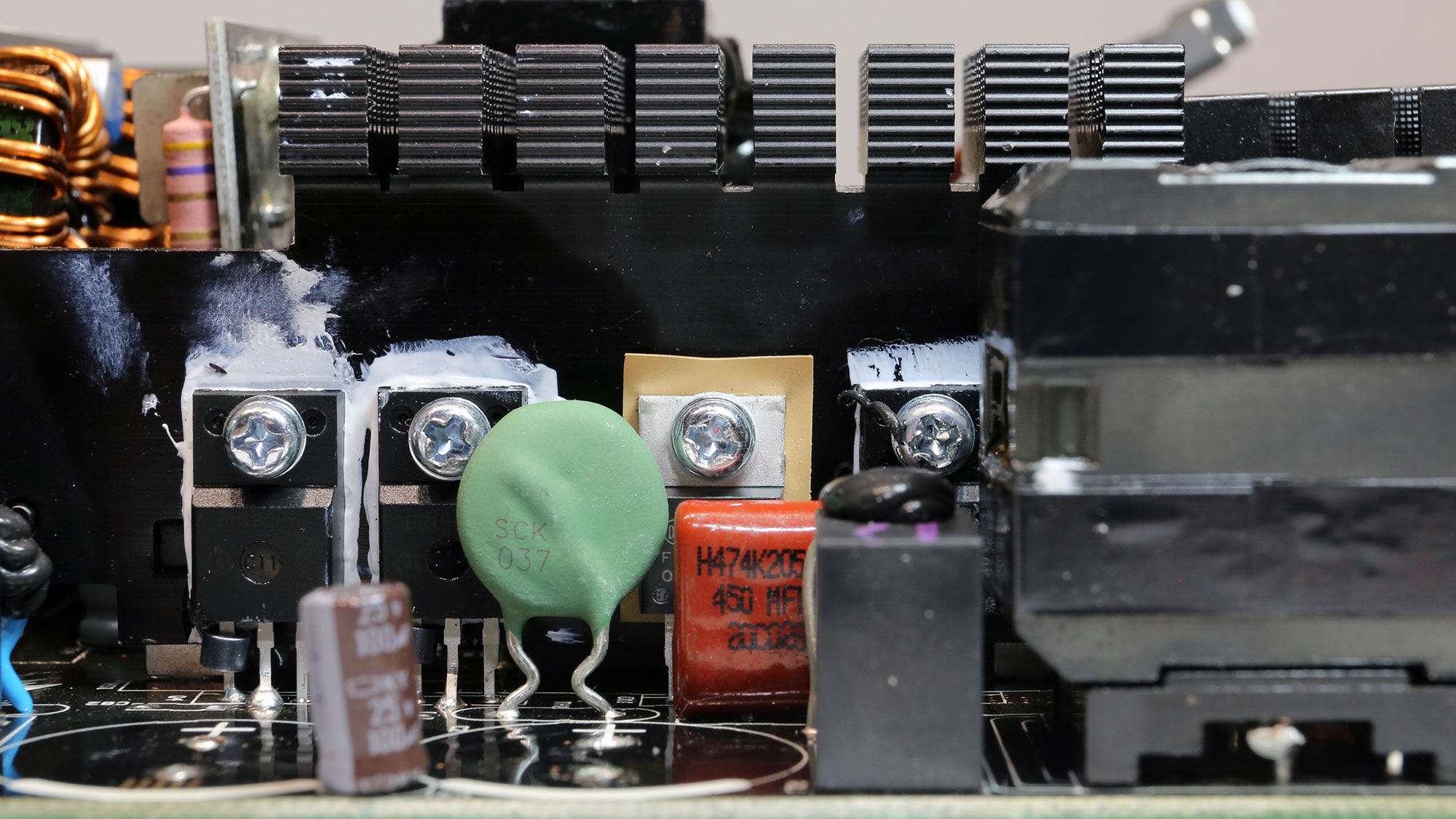
APFC converter
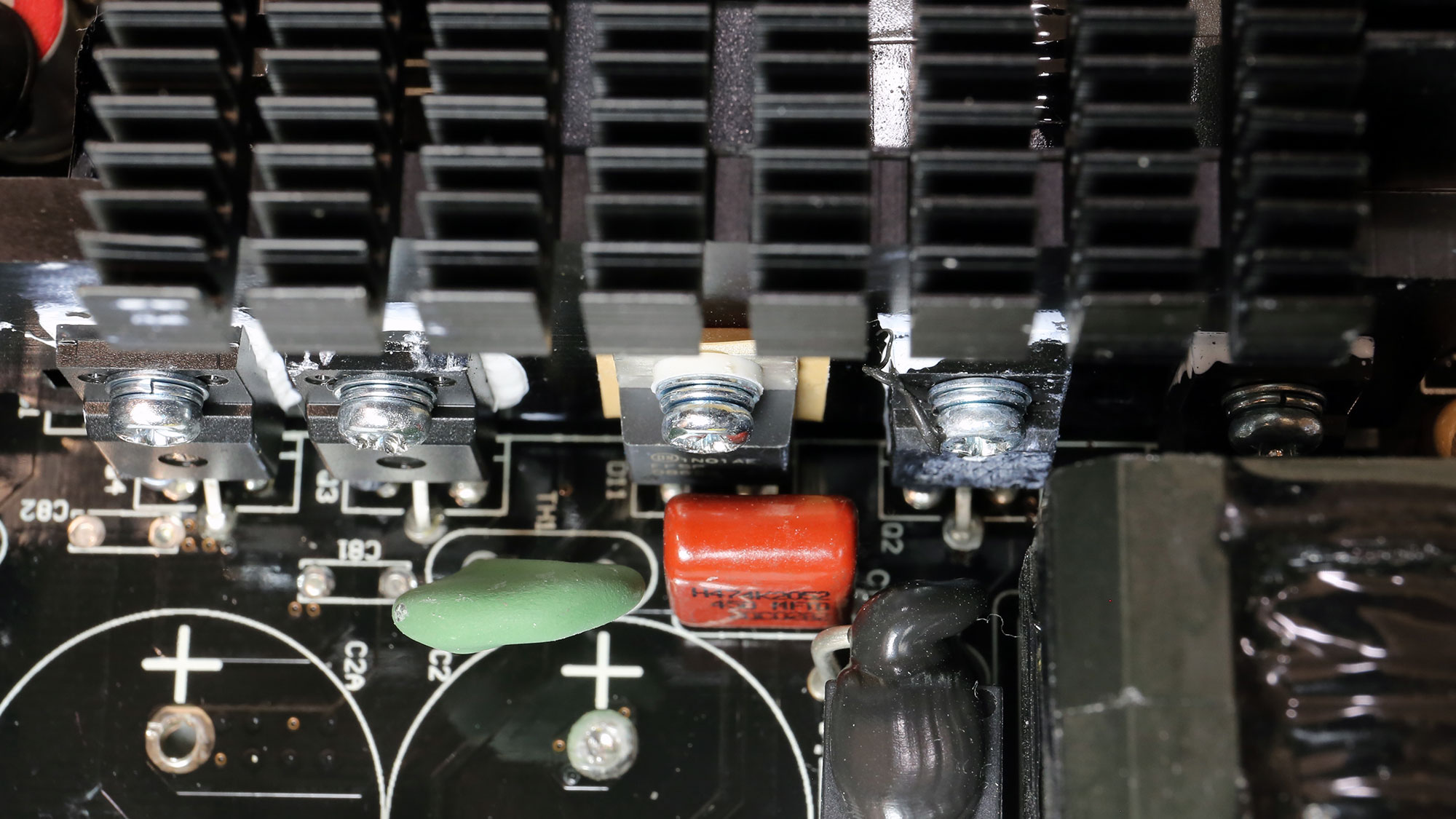

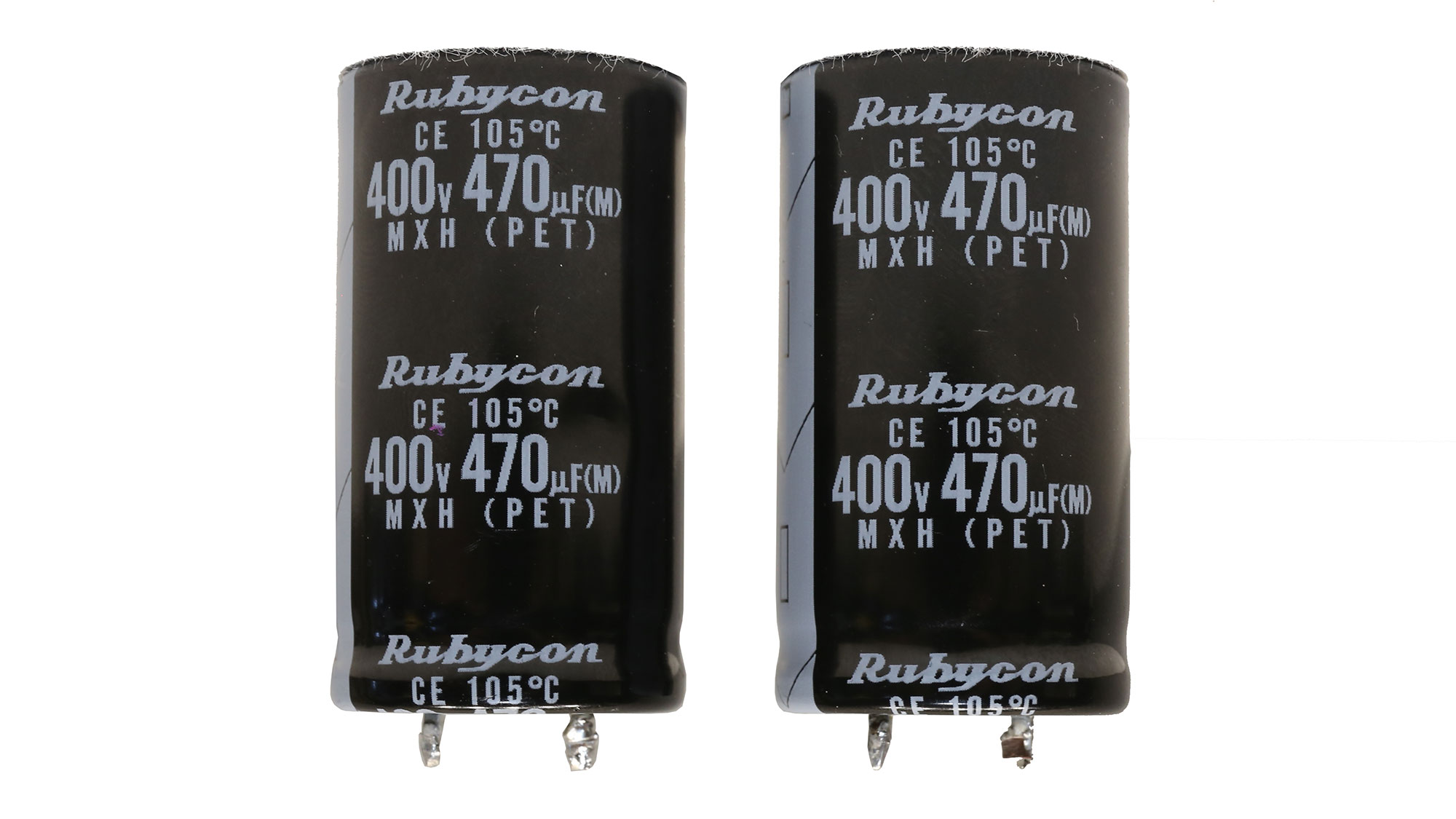
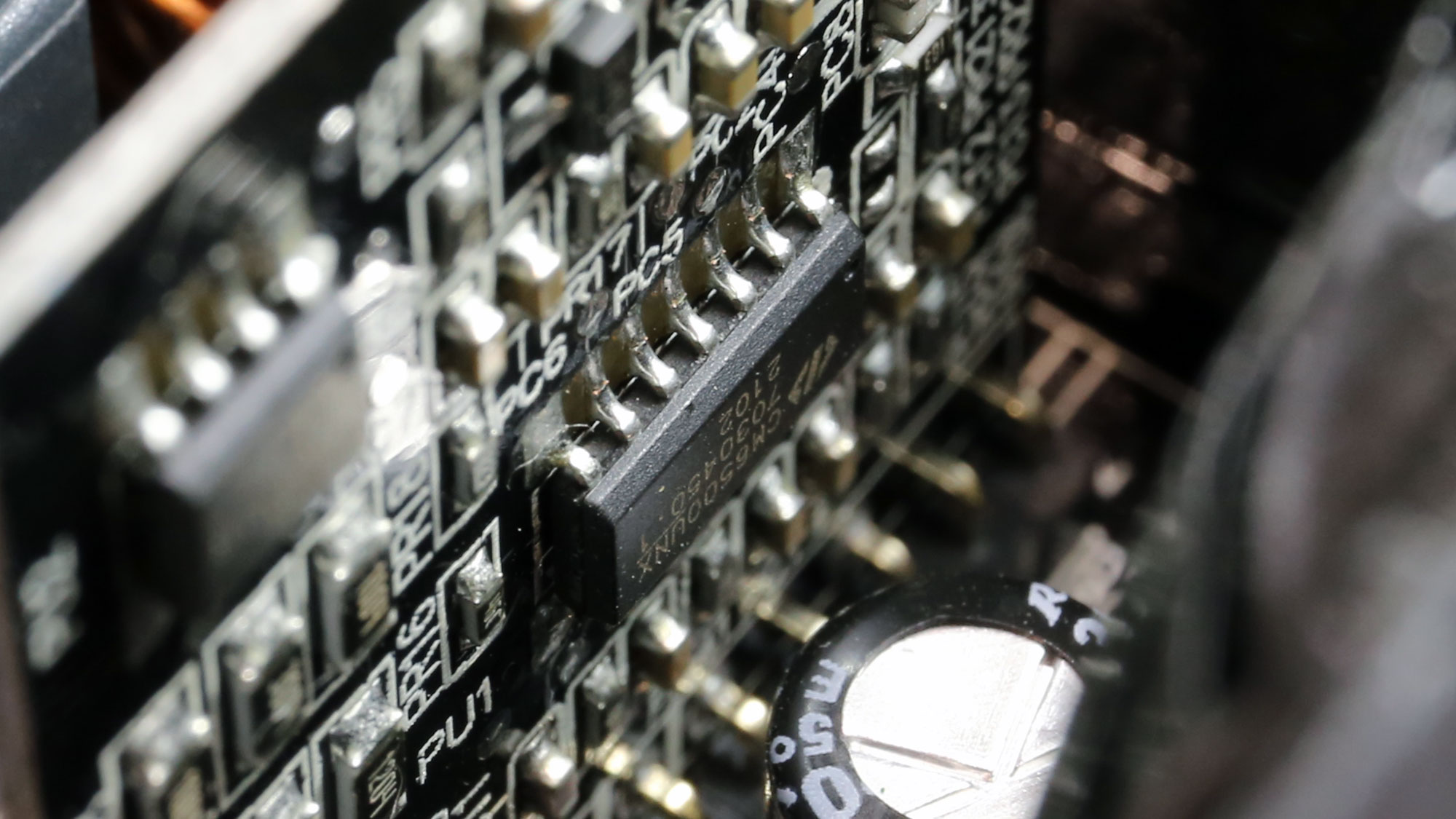
The APFC converter uses two Vishay FETs and a single boost diode, by On Semiconductor. These are high-quality parts.
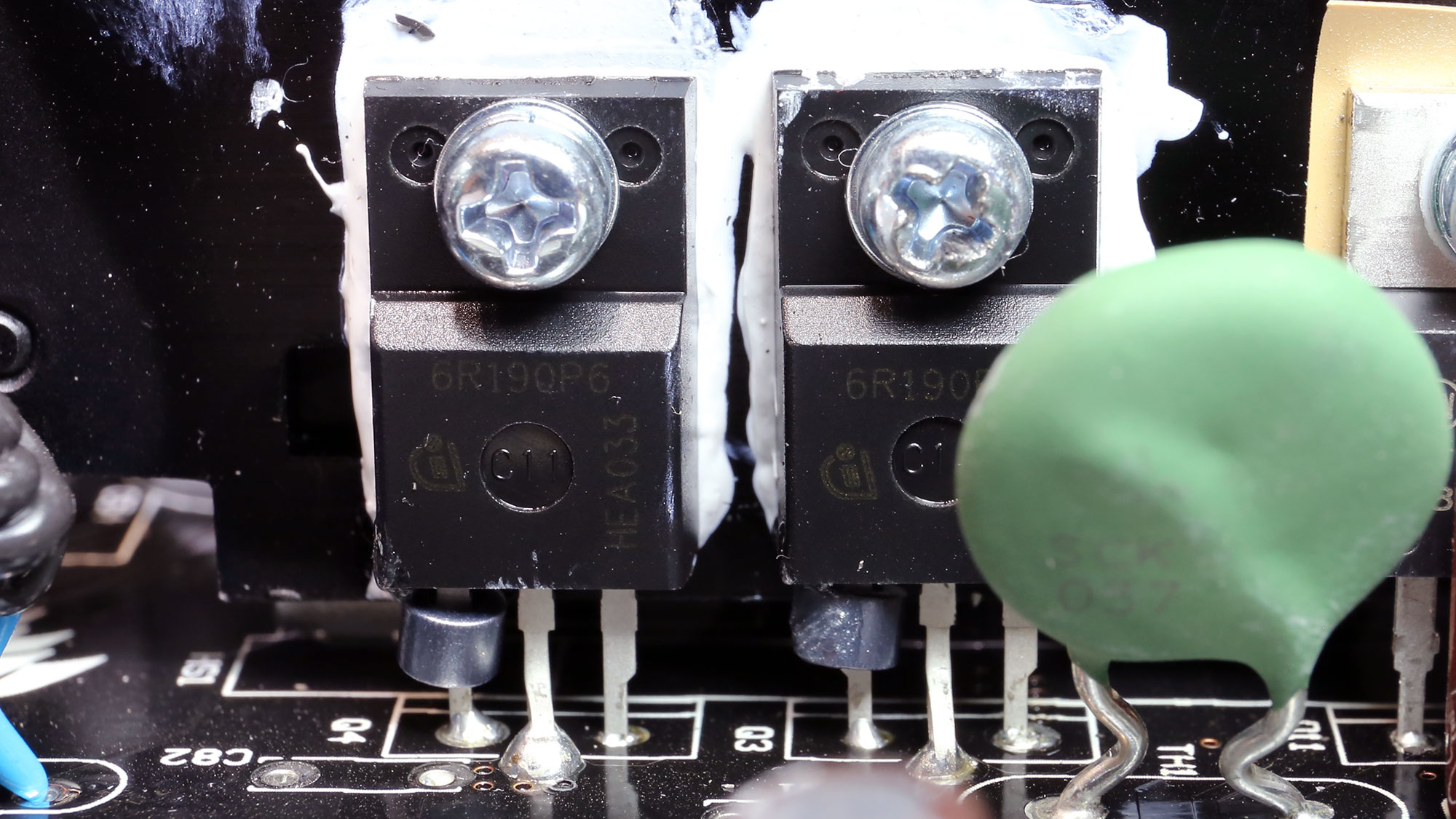
Main FETs and primary transformer
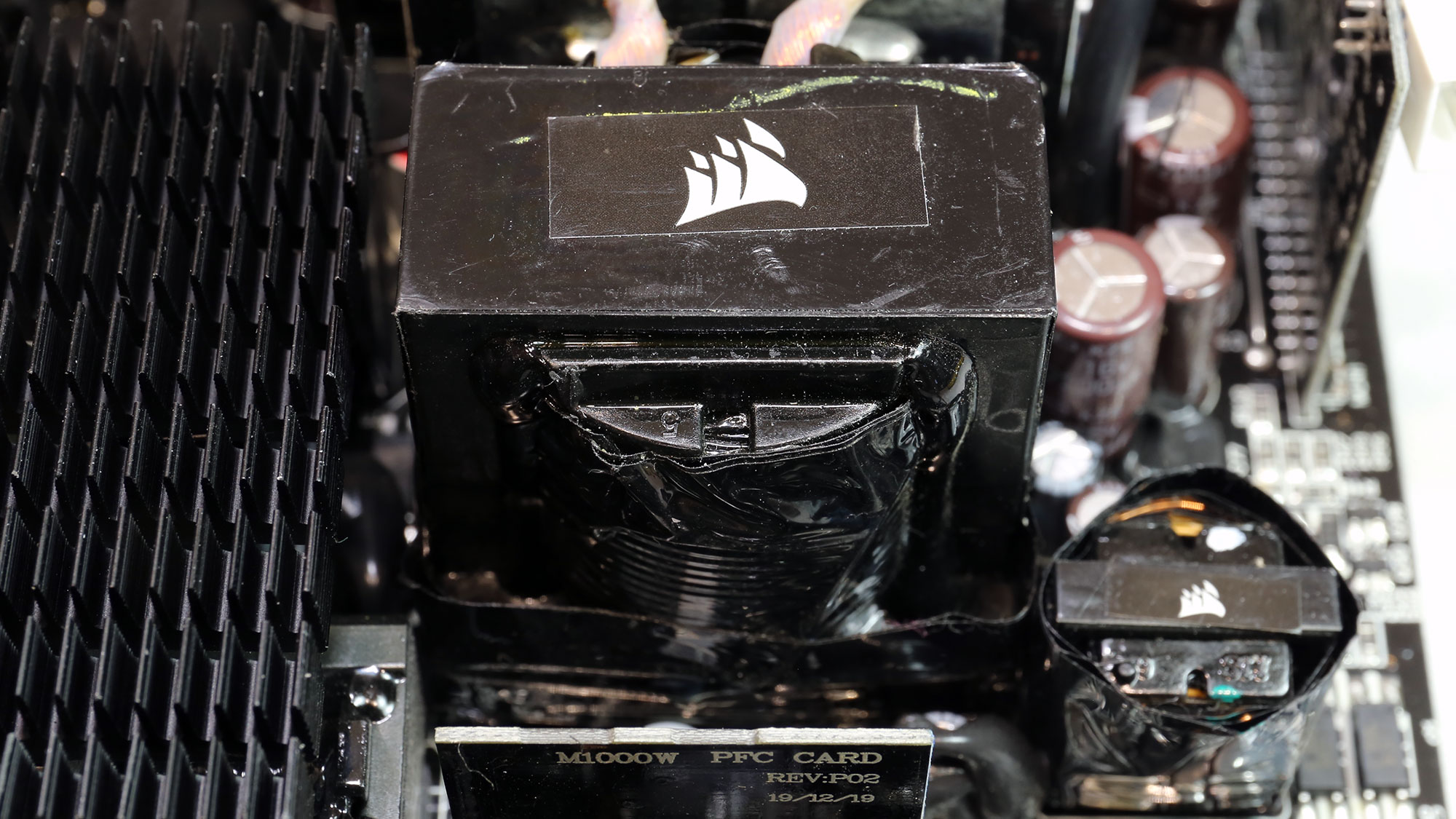
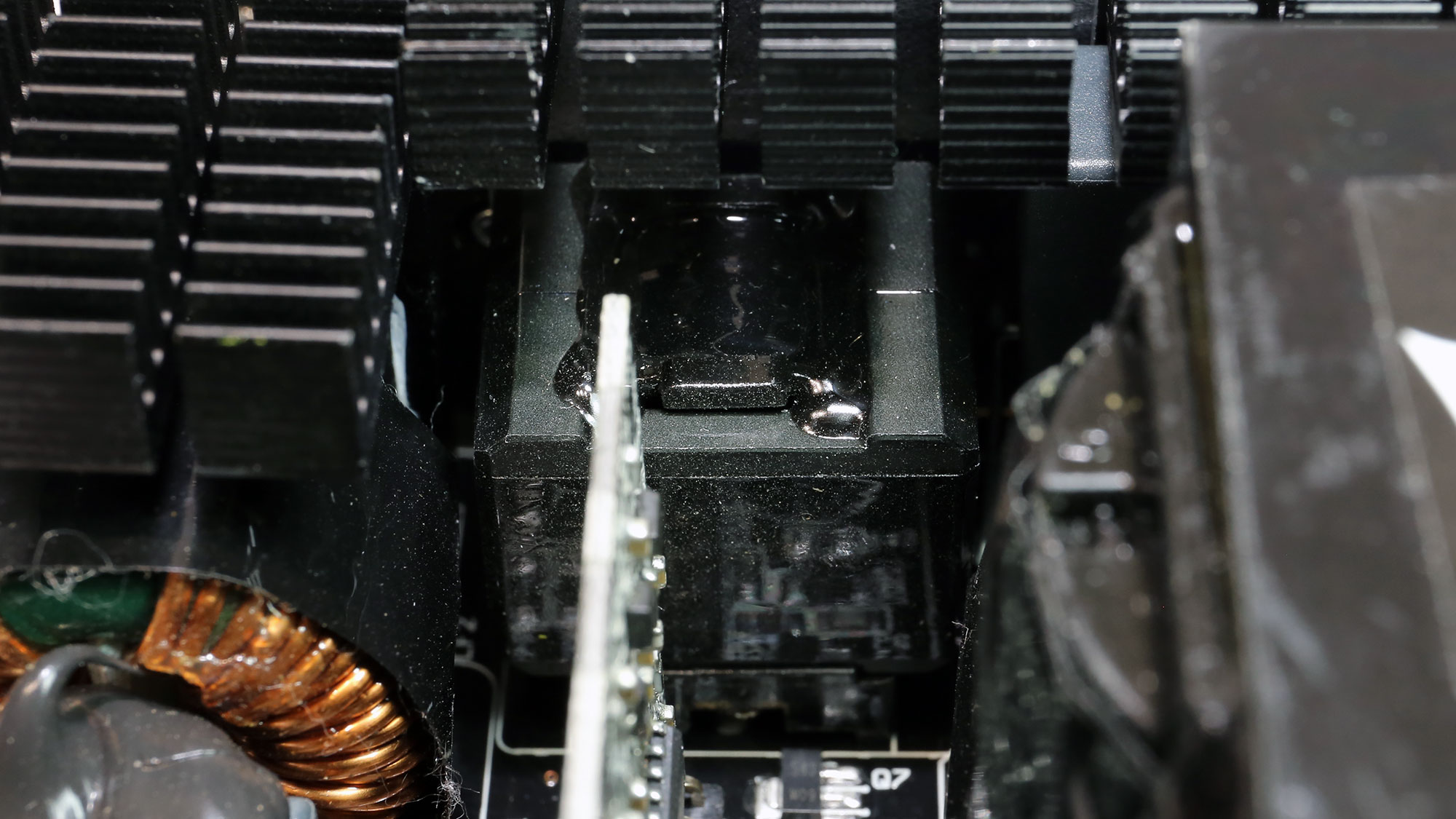

The main switching FETs, provided by Infineon, are installed into a half-bridge topology. An LLC resonant converter is also used to boost efficiency.
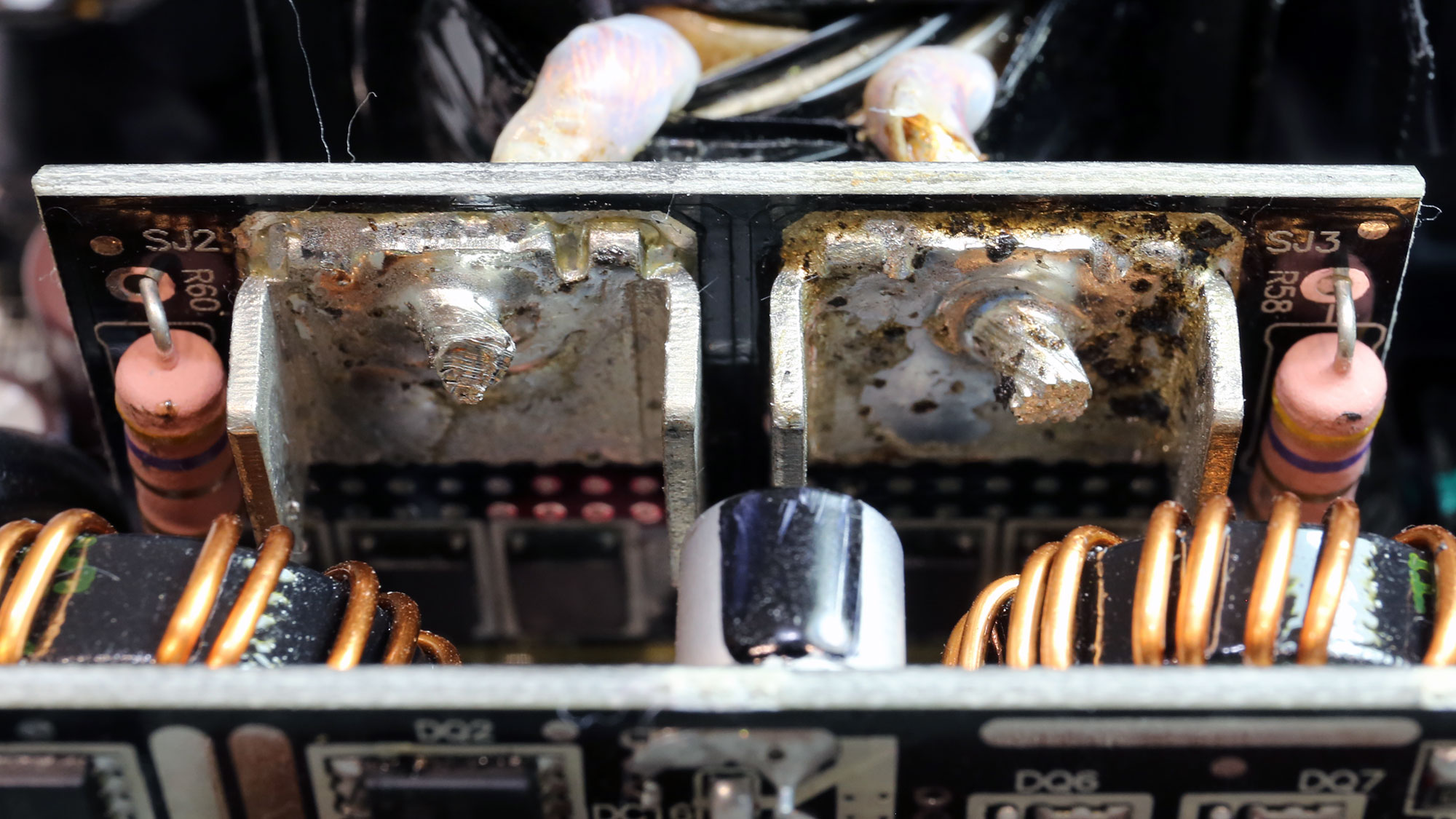
12V FETs and VRMs
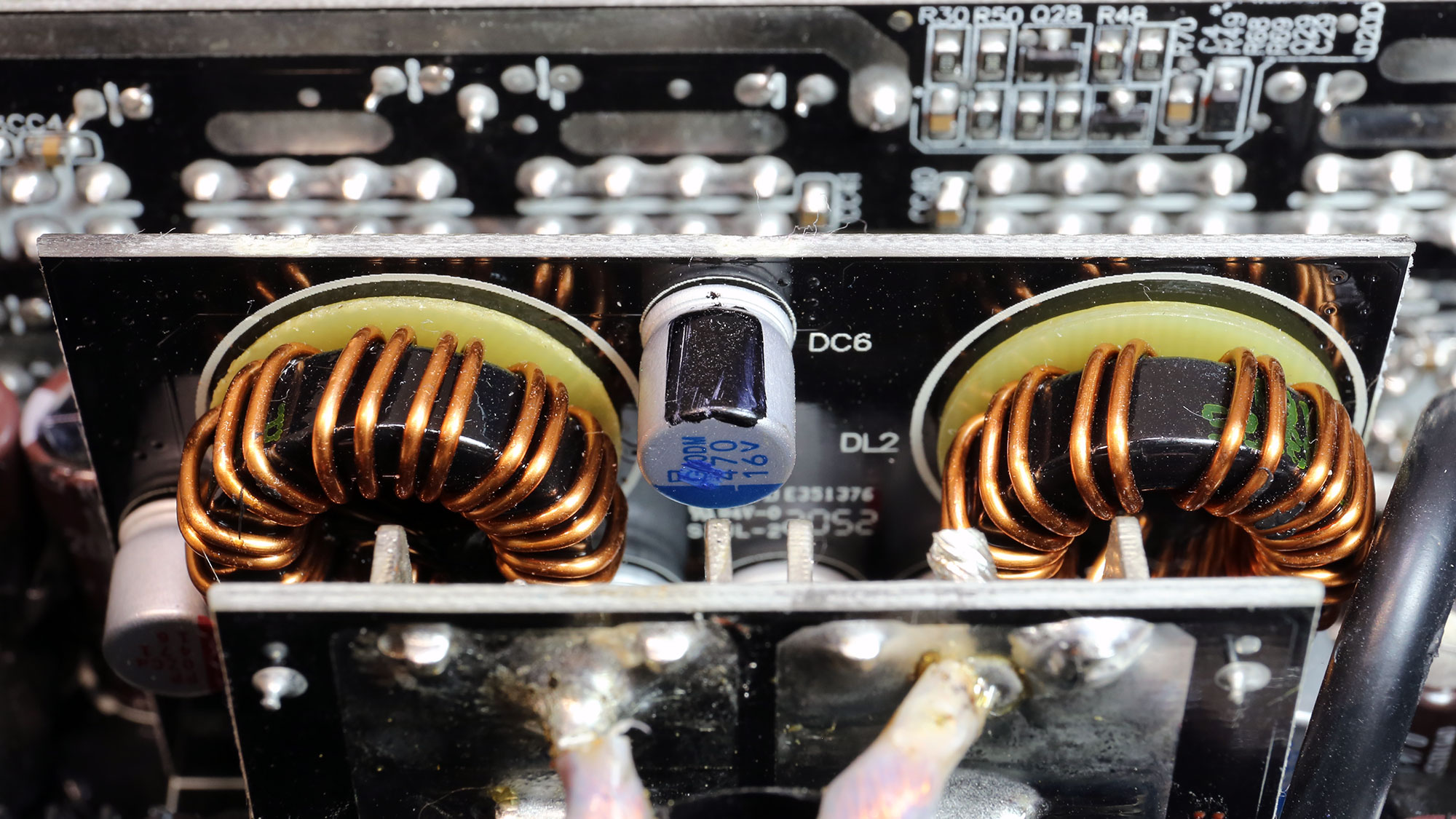
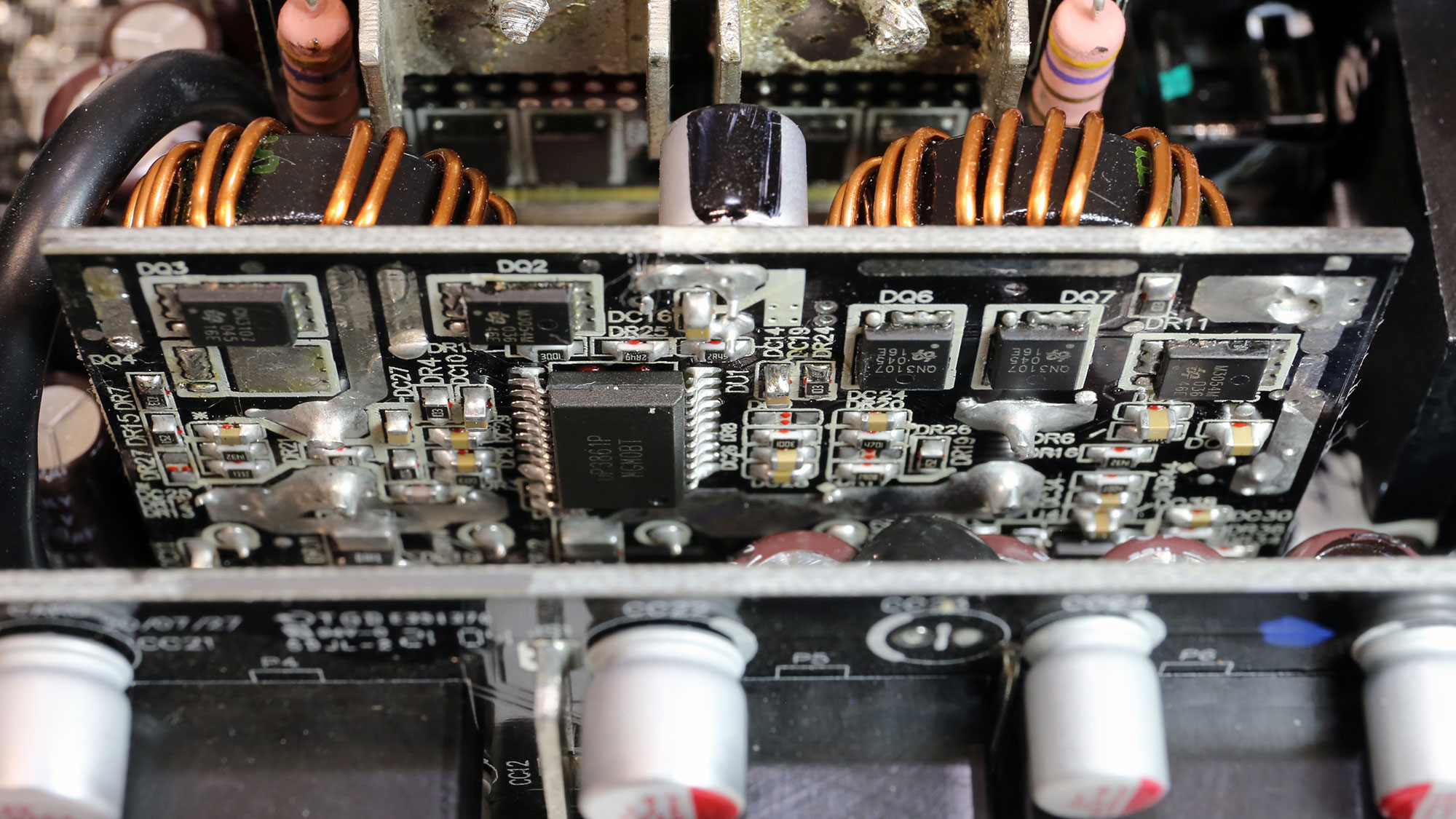
Six FETs regulate the 12V rail, and the minor rails are generated through a pair of DC-DC converters.

Filtering caps
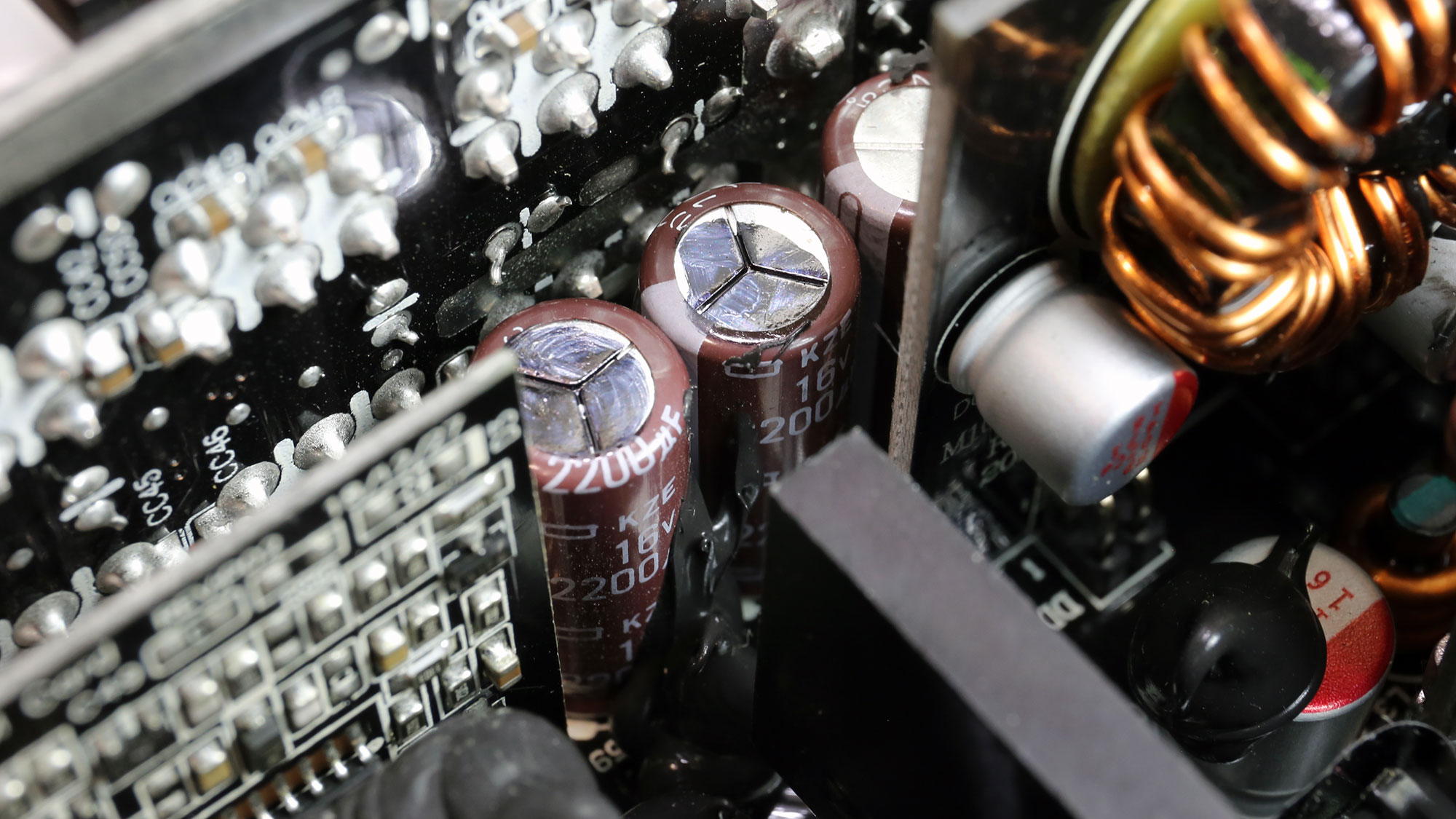
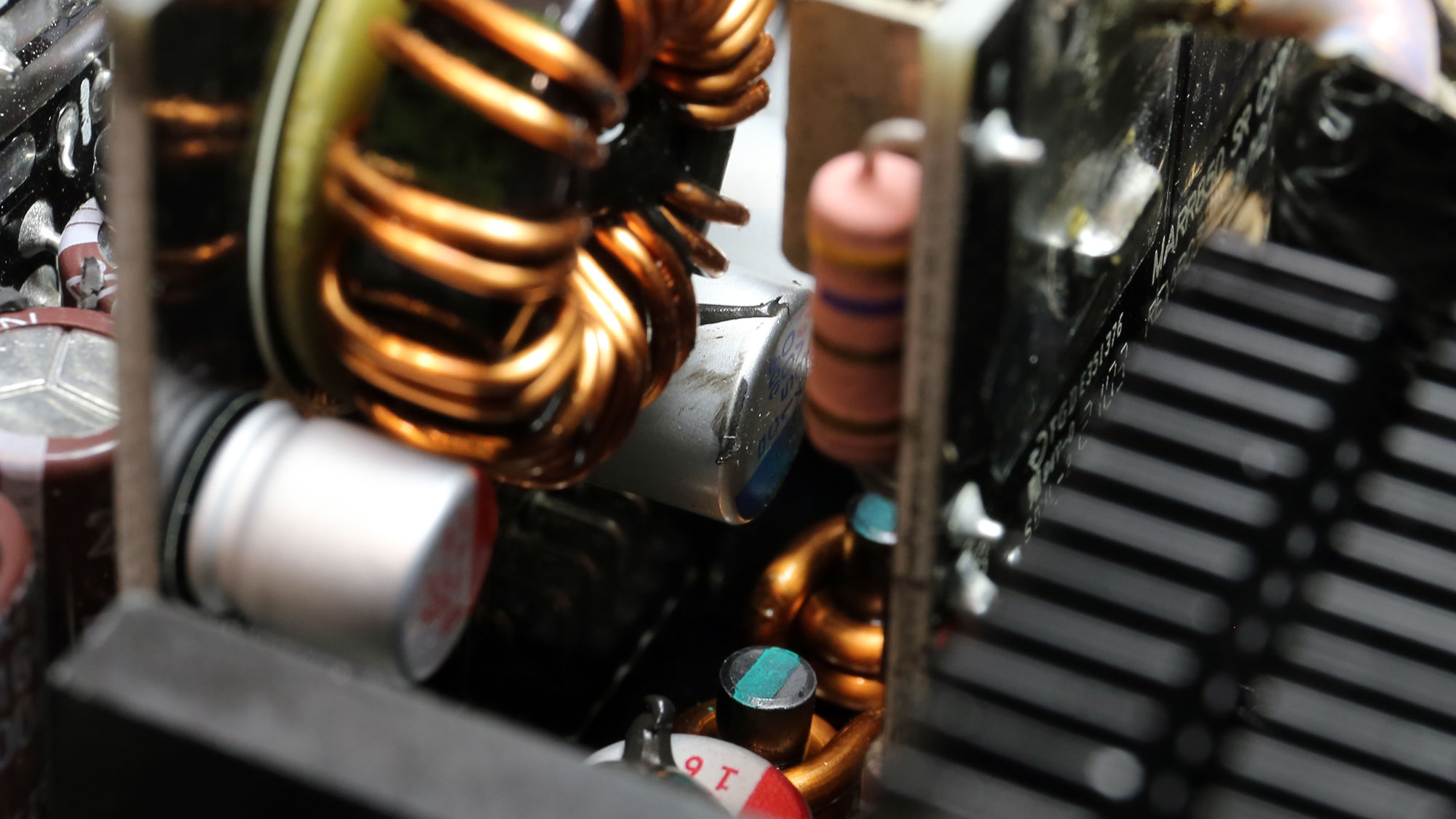
The electrolytic caps are by Chemi-Con and Rubycon. Lots of polymer caps are also used, for ripple filtering.
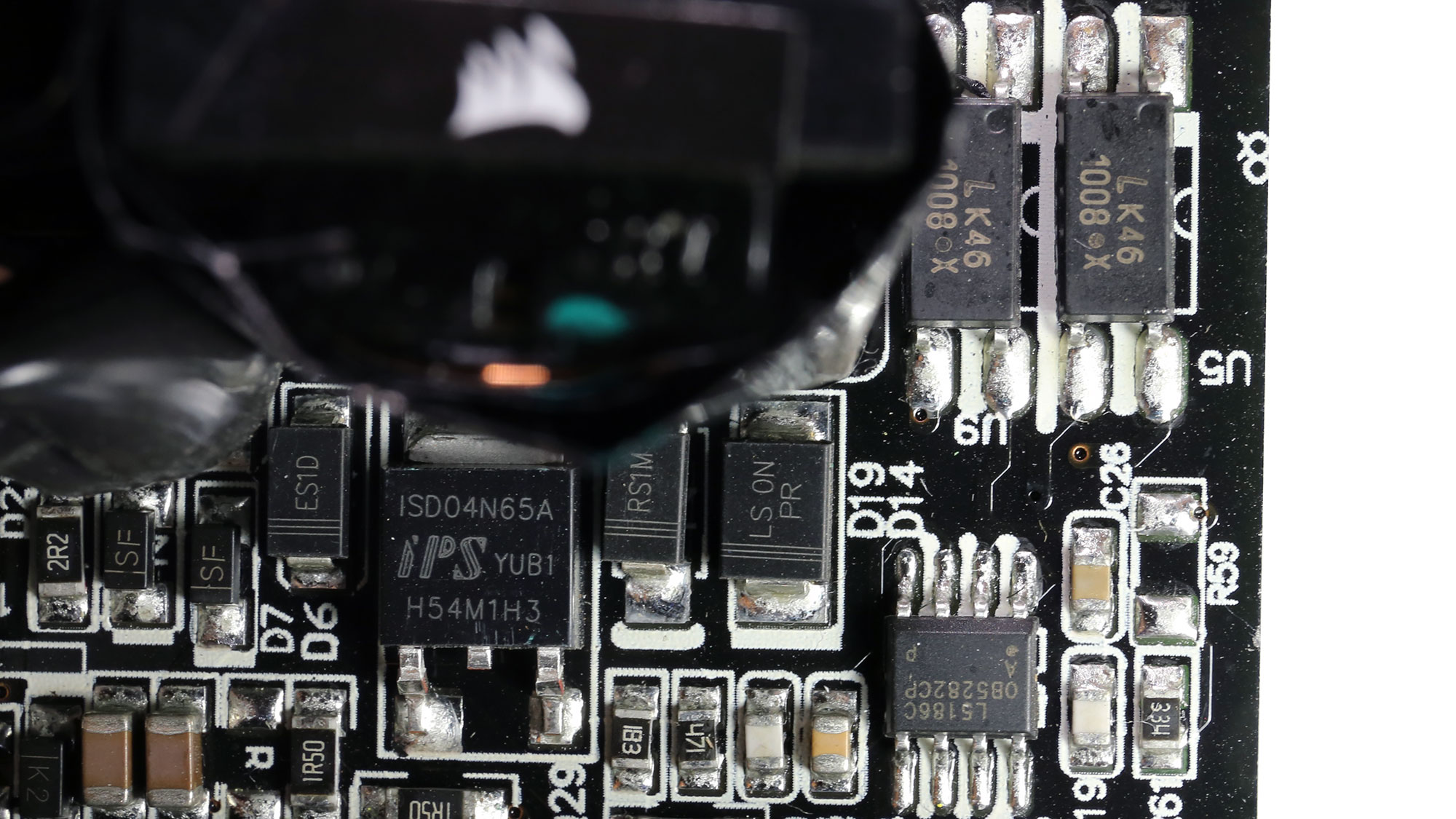
5VSB circuit
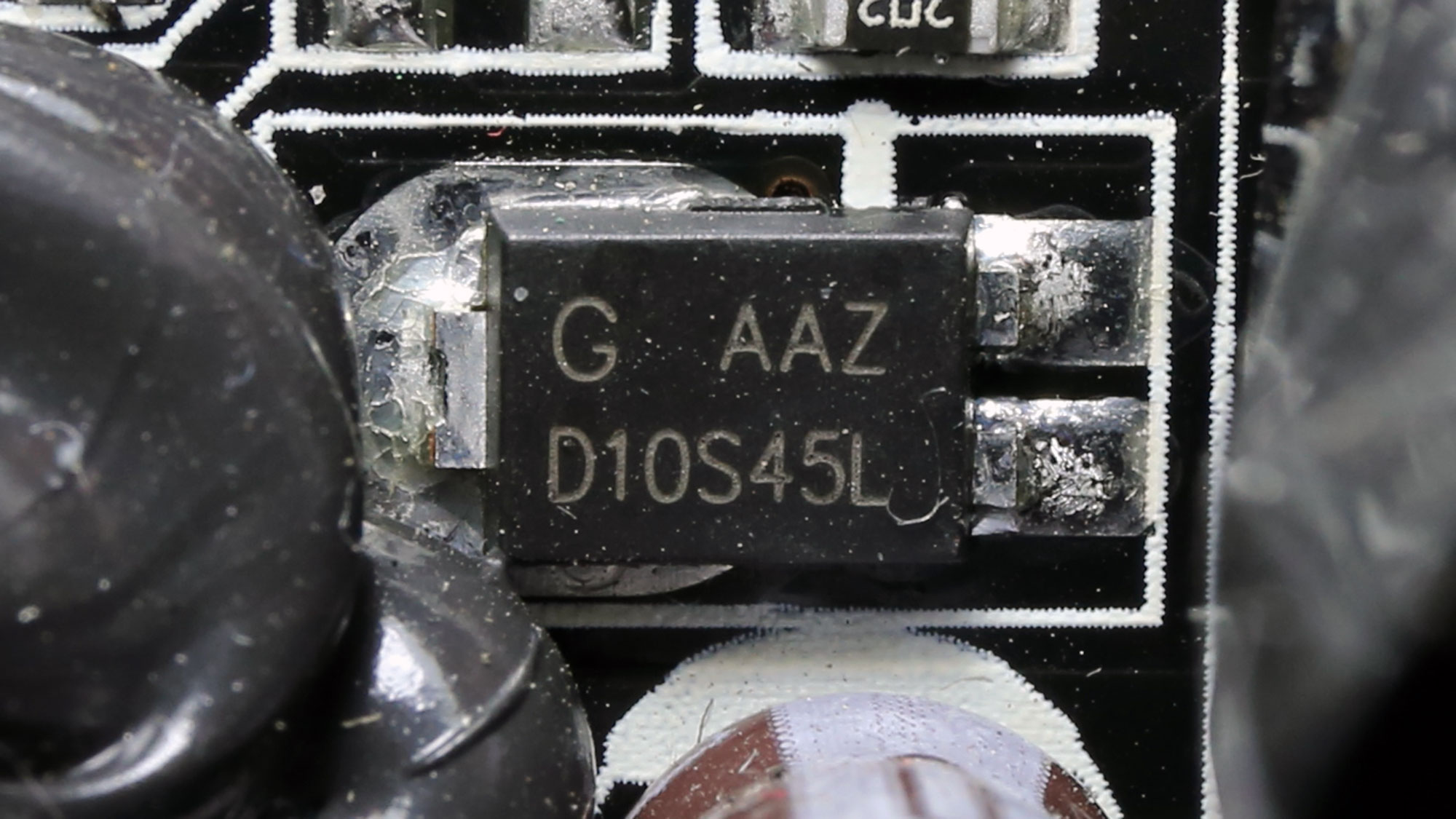
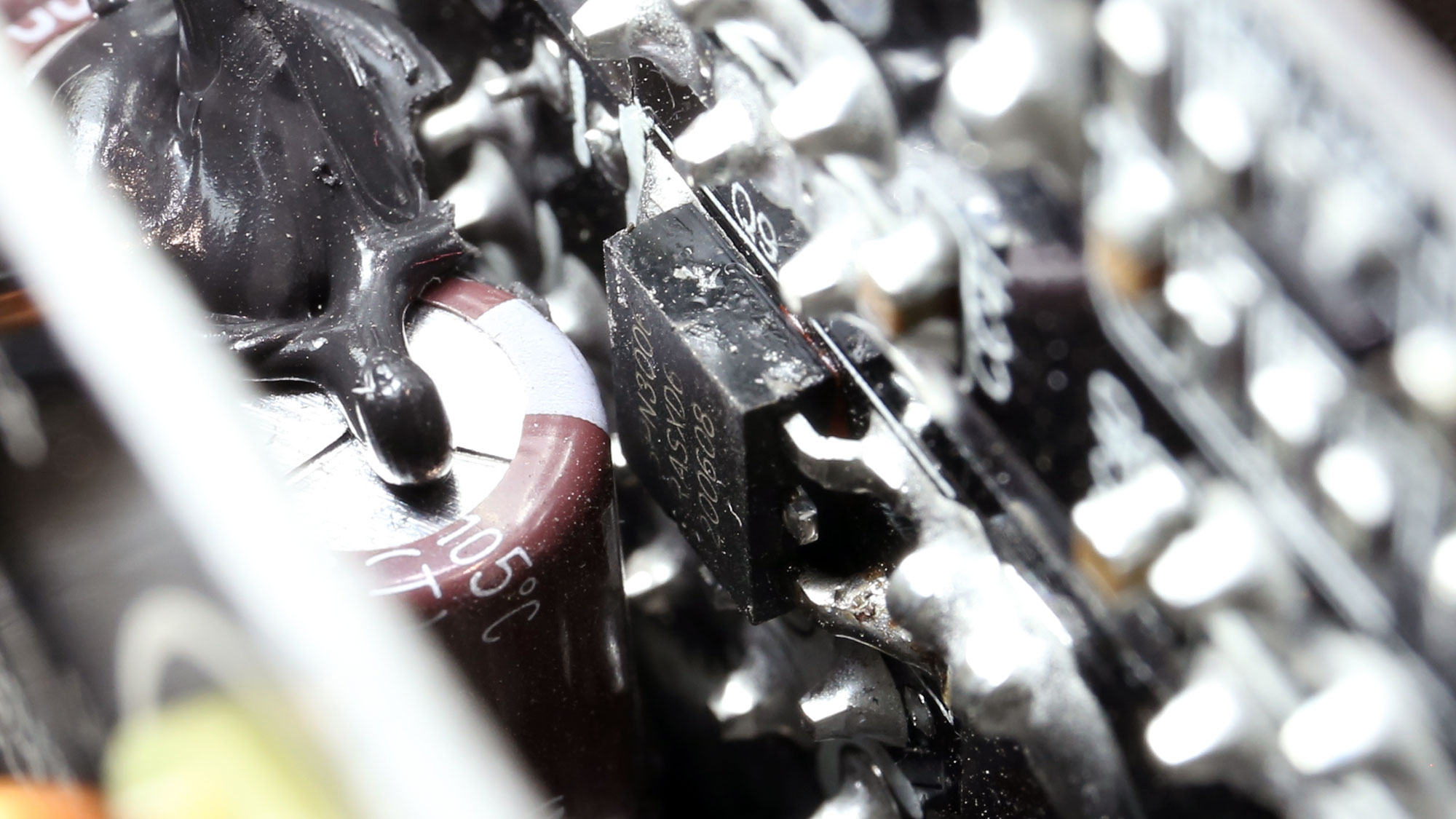
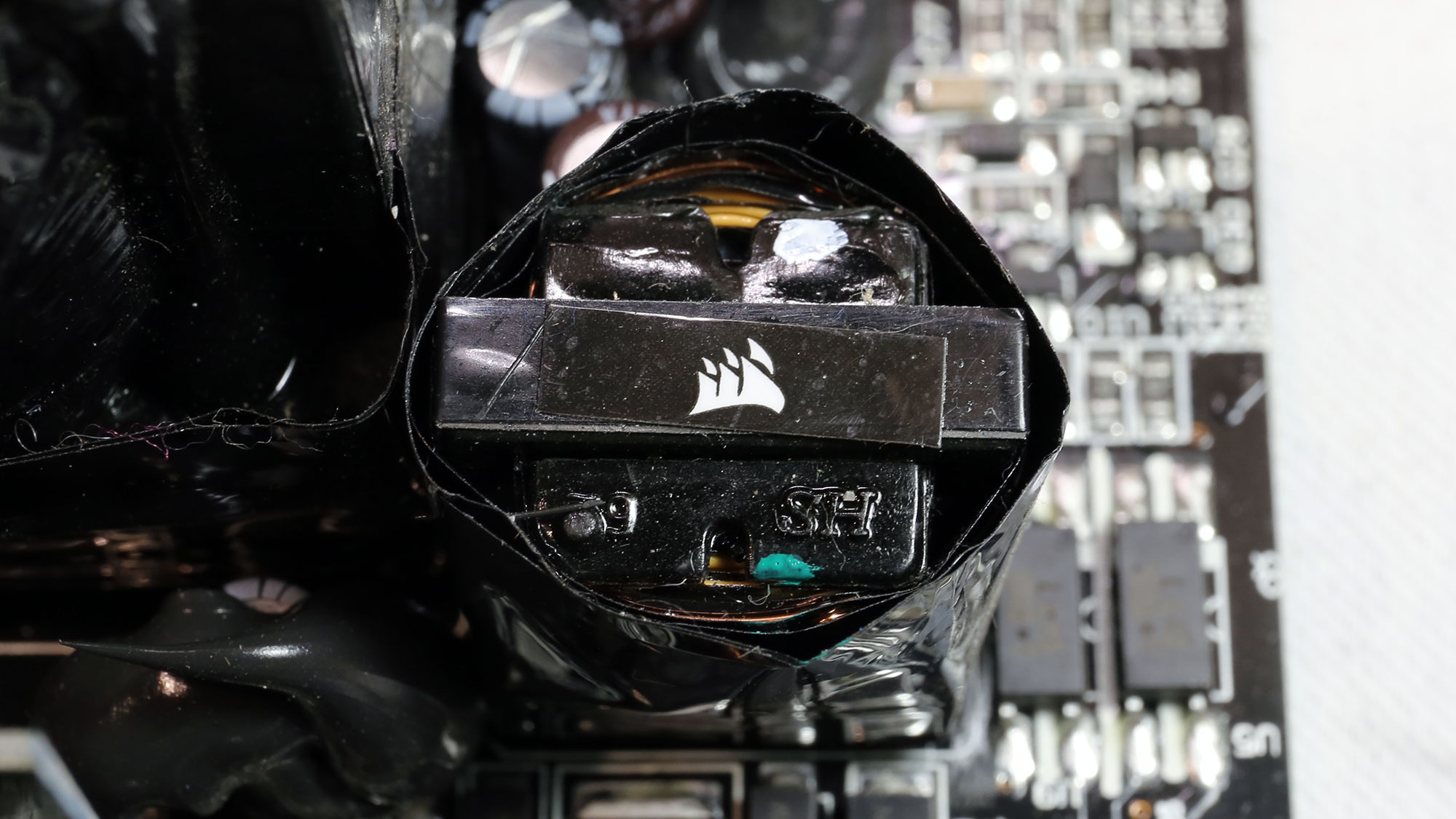
The 5VSB rail uses an SBR on its secondary side, so its efficiency will take a hit.

The supervisor IC, a Weltrend WT7502R, is installed on the same board with the fan controller.
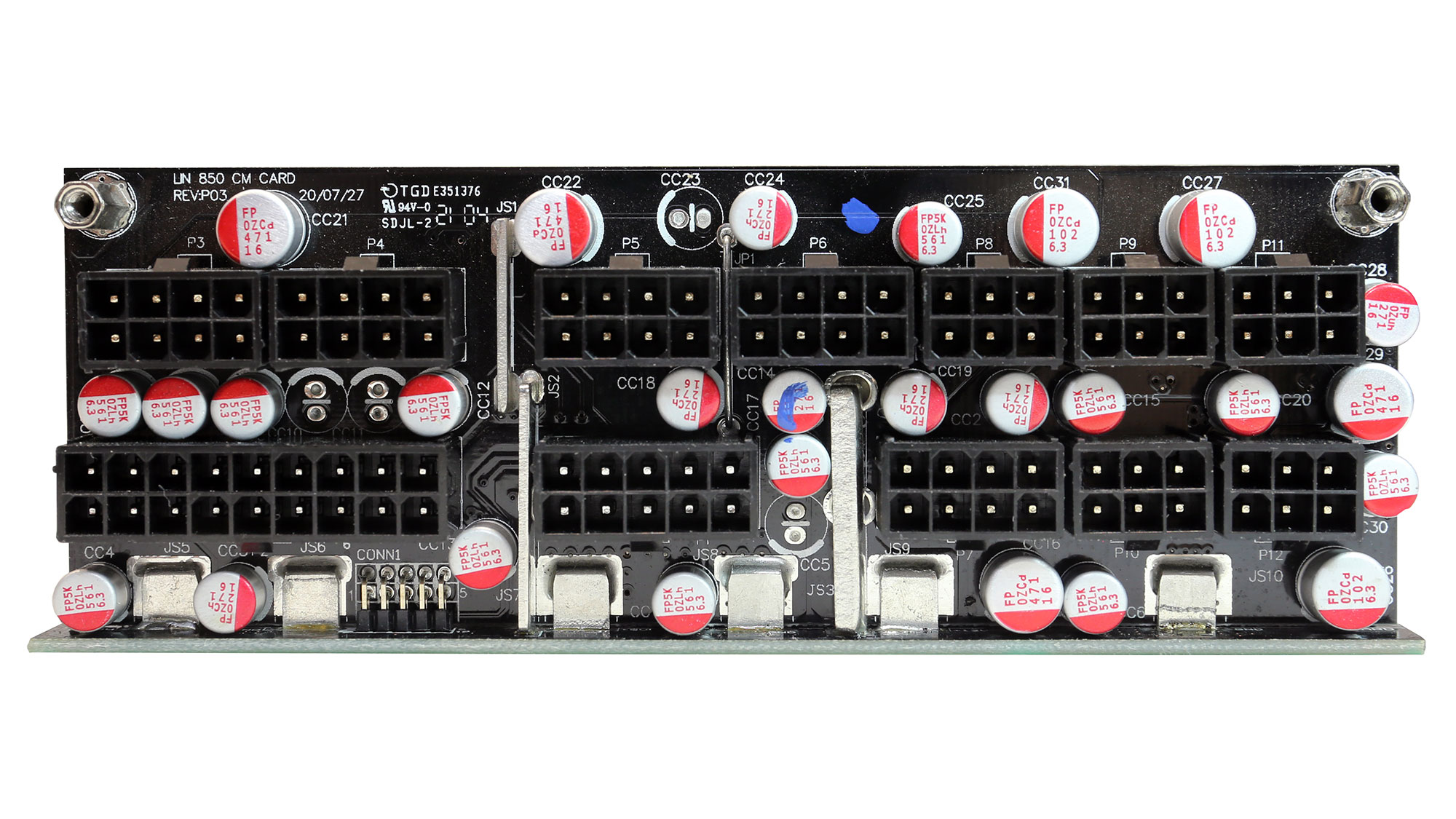
Modular board front
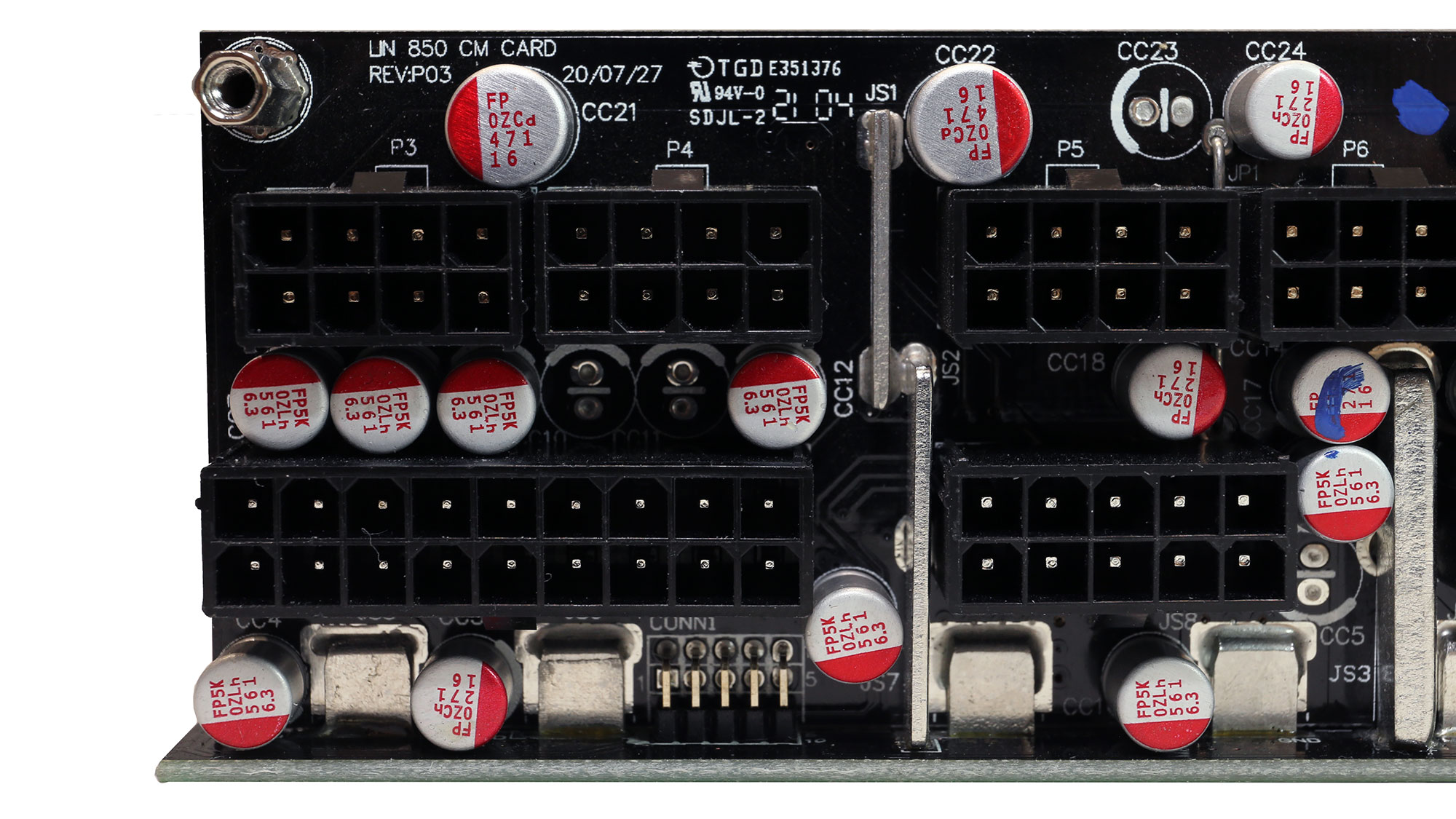
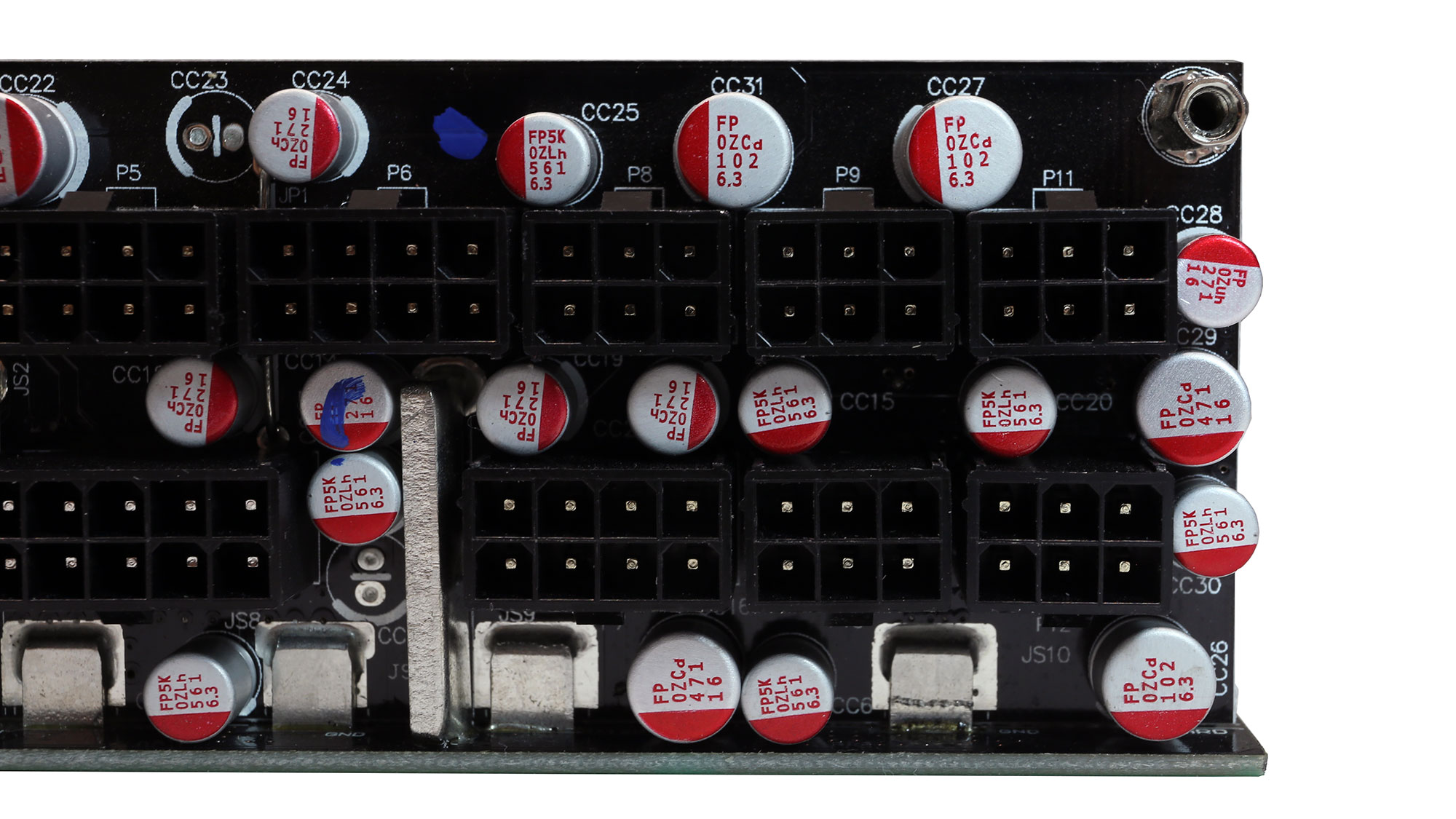
Lots of polymer fans are installed on the face of the modular board, forming an addition ripple filtering layer.
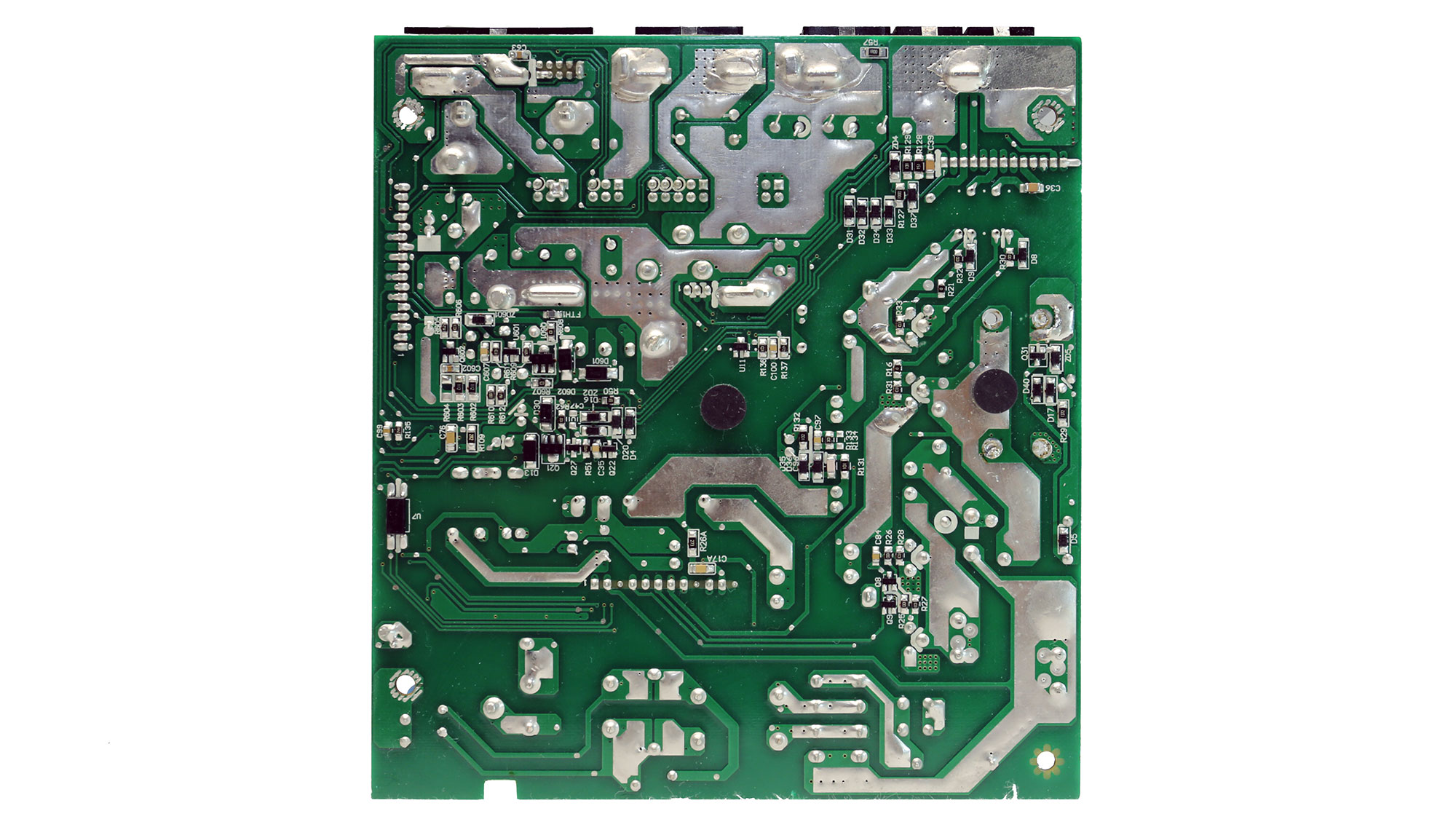
Soldering quality



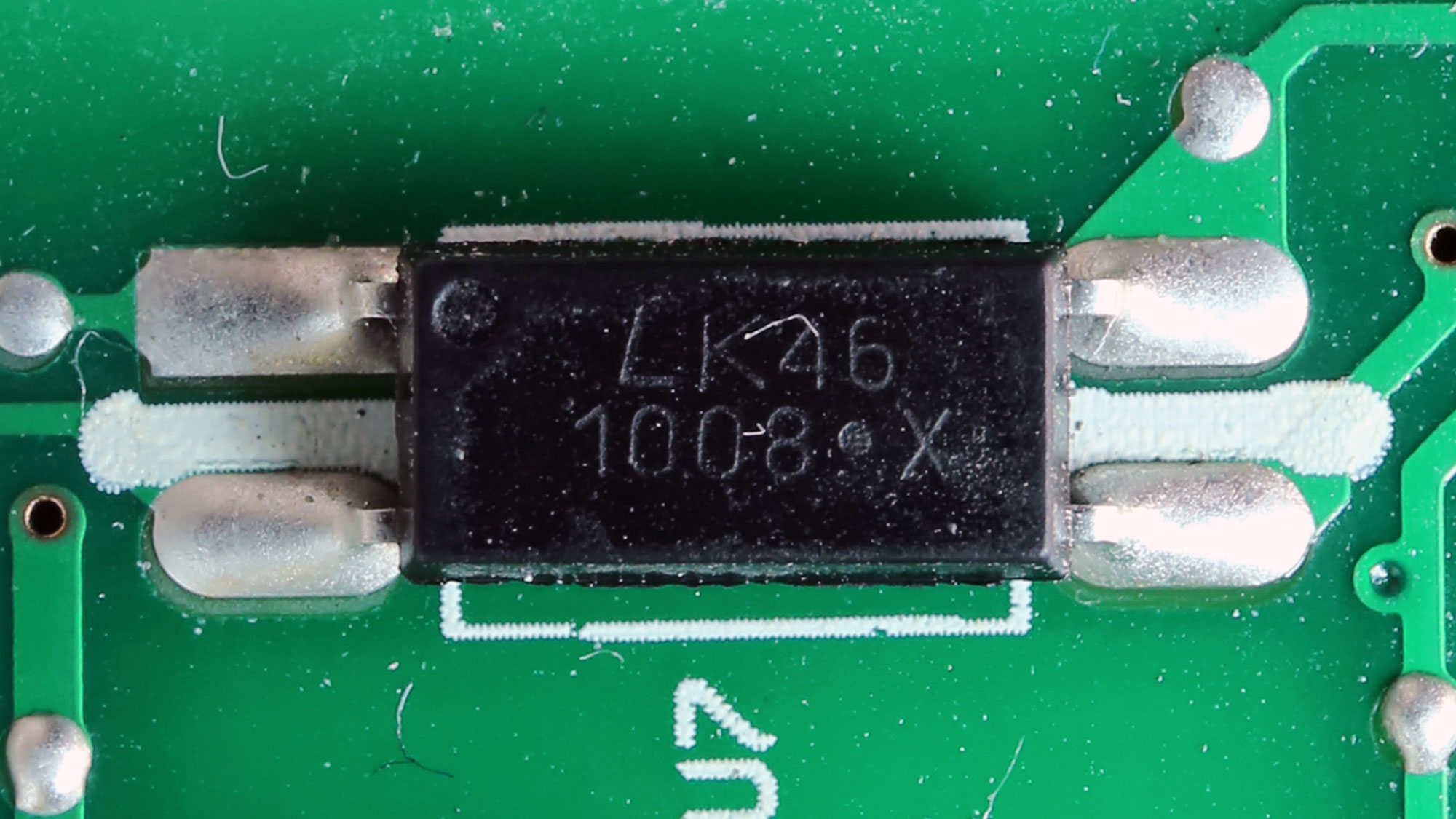
Soldering quality is good.
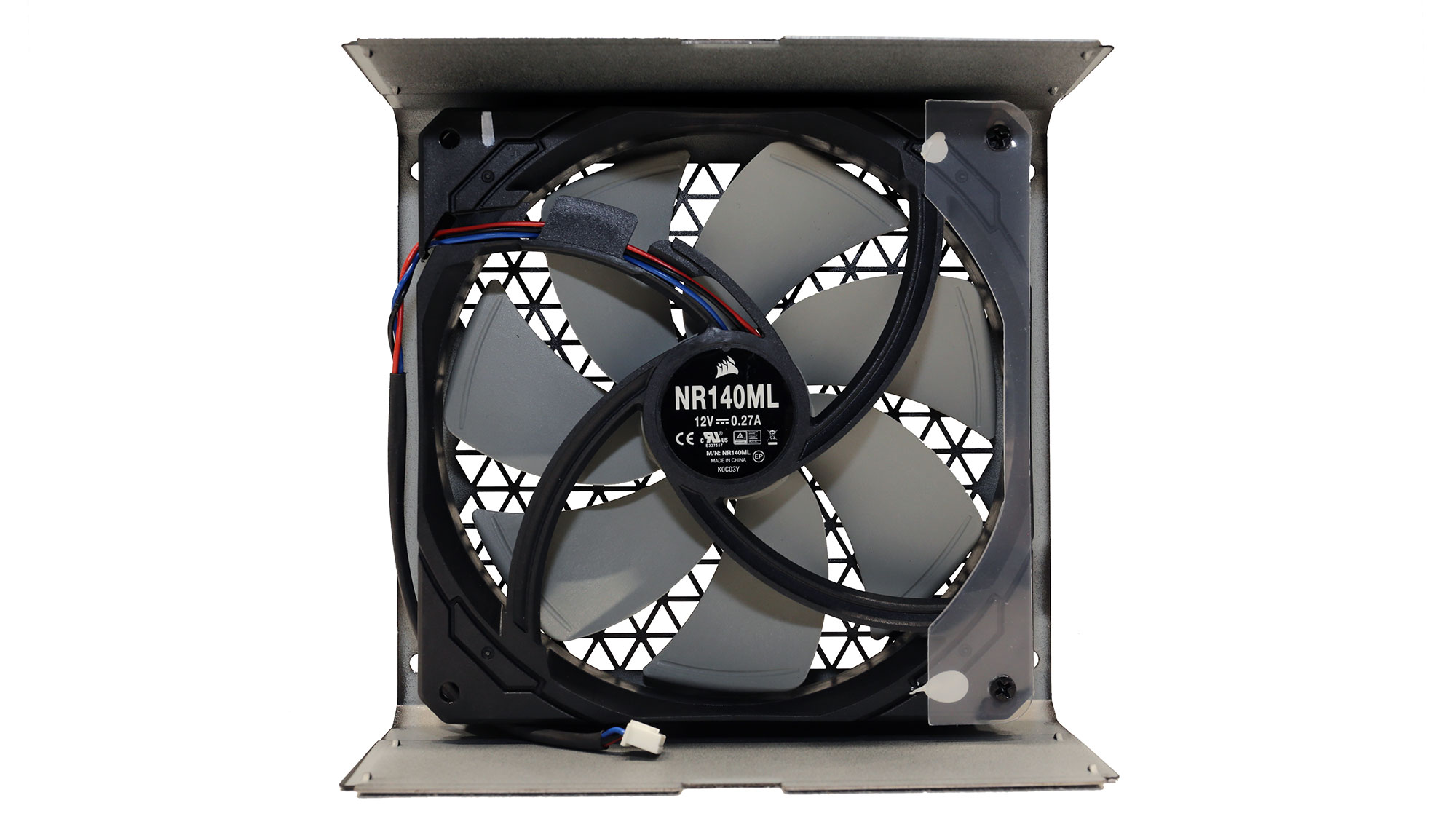
Cooling fan


The magnetic levitation fan is among the notable changes in the new RMx units. It isn't as quiet as the rifle bearing fan that the older RMx units use, but it is far more reliable, especially at high operating temperatures.
MORE: Best Power Supplies
MORE: How We Test Power Supplies
MORE: All Power Supply Content
Current page: Specifications and Part Analysis
Next Page Load Regulation, Hold-Up Time, Inrush & Leakage Current, Efficiency and Noise
Aris Mpitziopoulos is a contributing editor at Tom's Hardware, covering PSUs.
-
Isokolon shame they changed the fan. the 2015 & 2018 RMx were so great for low-noise enthusiasts.Reply
how the review classifies an almost 30db unit as "quiet" is beyond me. -
Udyr What makes this unit better than the Toughpower GF1?Reply
https://www.tomshardware.com/reviews/thermaltake-toughpower-gf1-850w-power-supply -
jsz031 Hi Aris.. like your reviews..Reply
small question. I noticed the Bulk/hold up caps get higher with wattage. can you explain how this impacts a general PSU?
for example/off topic, I have a 5 year old 550w G2 and it has a 400v 470uf cap. Just purchased a 550w g3 and the cap is lower capacity @ 400v 390uf.
Does this mean anything or am I overthinking it? is the 550w g2 better than "base" spec? I understand leakage can occur over time, I'm just not sure if its a downgrade or upgrade in specific areas.
thank you. -
jayjr1105 Reply
As long as they are meeting the ATX spec of 17ms hold up time, it doesn't really matter. The G2 was probably overkill so they cut costs by going with a lower capacity one.jsz031 said:Hi Aris.. like your reviews..
small question. I noticed the Bulk/hold up caps get higher with wattage. can you explain how this impacts a general PSU?
for example/off topic, I have a 5 year old 550w G2 and it has a 400v 470uf cap. Just purchased a 550w g3 and the cap is lower capacity @ 400v 390uf.
Does this mean anything or am I overthinking it? is the 550w g2 better than "base" spec? I understand leakage can occur over time, I'm just not sure if its a downgrade or upgrade in specific areas.
thank you. -
tomkawal Reply
..and worst quality coming from production line! Mine was covered with thick layer of metal salts from soldering. It stopped turning on. Works again after thorough cleanup.Admin said:The new Corsair RM850x is among the best PSUs in its category.
Corsair RM850x (2021) Power Supply Review : Read more -
tomkawal Beautifully presented. I was not so lucky with the unit I got, which stopped working after a month. Sent back to eBuyer guys and received it again not fixed (generally they requested ALL cables where I wanted only brick swap - this is totally unacceptable for me when the wires are in place tied to enclosure!) Raised ticket with Corsair with no answer in 2 days. Fixed on my own with one hour of cleaning the PCB from thick layer of soldering flux on the bottom side of PCB which caused leakage currents all over the board. Now it works. Horrendous experience and I don't recommend none of these businesses.Reply
